everything a tourist could want.
history. The many heritage sites in the area include the Samora Machel monument near Mbuzini and the Barberton Makhonjwa Mountains World Heritage Site (pictured), boasting rock formations dating back more than 3.5-billion years. Other sites not to be missed are the mining village of Pilgrim’s Rest, the Highveld Heritage Route (which abounds with adventurous tales from history), the stone circles of Mpumalanga and Goliath’s footprint to name just a few. Mpumalanga is rich in culture and boasts the Swazi, Ndebele and Shangaan people with icons like Dr Esther Mahlangu who has managed to preserve, package and export the vibrant geometric art of the Ndebele globally.

THE GUIDE TO BUSINESS AND INVESTMENT IN




Bird watchers can have a glimpse of more than 500 different birds endemic to the Kruger National Park or the town of Chrissiesmeer, the centre of South Africa’s own Lake District where four river systems start their journeys across the country.
The small tourist town of Dullstroom is referred to as South Africa’s trout-fishing mecca. Mpumalanga is an ideal sporting destination with several world-class golf courses and the Mbombela Stadium that was built for the FIFA World Cup in 2010 and has subsequently hosted international football and rugby matches. Get off the beaten track and explore the many other tourism offerings of the Mpumalanga Province.





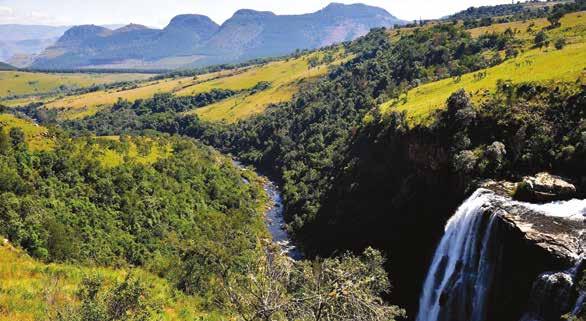
MPUMALANGA BUSINESS THE GUIDE TO BUSINESS AND INVESTMENT IN MPUMALANGA PROVINCE 2023/24 EDITION WWW.GLOBALAFRICANETWORK.COM | WWW.MPUMALANGABUSINESS.CO.ZA JOIN US ONLINE MPUMALANGA BUSINESS 2021/22 THE GUIDE TO BUSINESS AND INVESTMENT IN MPUMALANGA MPUMALANGA BUSINESS 2021/22 EDITION THE GUIDE TO BUSINESS AND INVESTMENT IN MPUMALANGA PROVINCE WWW.GLOBALAFRICANETWORK.COM | WWW.MPUMALANGABUSINESS.CO.ZA JOIN US ONLINE MPUMALANGA BUSINESS THE GUIDE TO BUSINESS AND INVESTMENT IN MPUMALANGA PROVINCE 2018/19 EDITION WWW.GLOBALAFRICANETWORK.COM | WWW.LIMPOPOBUSINESS.CO.ZA JOIN US ONLINE JOIN US ONLINE WWW.GLOBALAFRICANETWORK.COM | WWW.MPUMALANGABUSINESS.CO.ZA MPUMALANGA 2018/19 MPUMALANGA BUSINESS
MPUMALANGA
tourism
Twitter: @Mtpatourism | Instagram: @mpumalangatourism
Contributing to the lifeblood of the province whilst unlocking the power of trees for a better tomorrow
Sappi Southern Africa has been providing the lifeblood for the province of Mpumalanga through its commercial plantations and its manufacturing facilities for many decades. Contributing over ZAR5.5 billion annually to the local economy, more than 43,000 people in the province depend on the company for their livelihood.


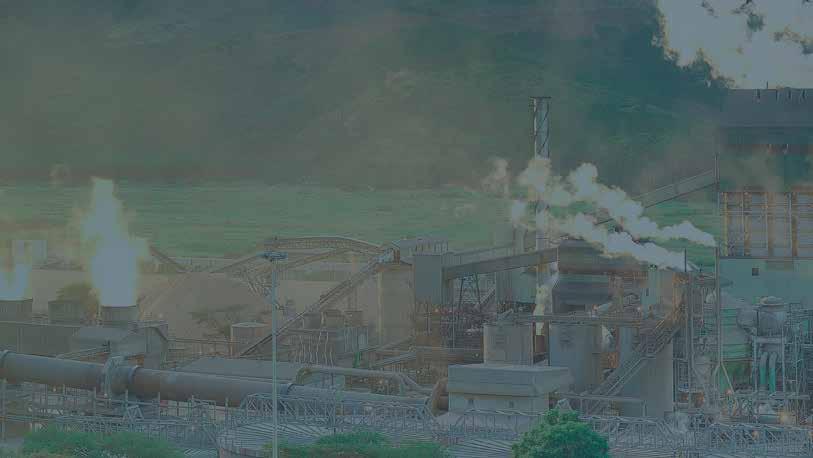


And all while the company is building a thriving world with a biobased circular economy. Utilising innovative approaches, we champion responsible forestry as we cultivate more purpose and value from each tree, by-product and resource. Our products are sustainable alternatives extracted from woodfibre to reduce the need for fossil-based materials used in everyday products.
sappi.com









The transformative power of business and investment

Investors are encouraged to investigate the wealth of opportunities in Mpumalanga, writes Isaak Mahlangu, CEO of the Mpumalanga Economic Growth Agency.
 Isaac Mahlangu, CEO, MEGA
Isaac Mahlangu, CEO, MEGA
It is with great pleasure that I address you as the CEO of the Mpumalanga Economic Growth Agency (MEGA). As the driving force behind the economic development of our remarkable province, it is my privilege to provide you with this message in the esteemed pages of the Mpumalanga Business journal.
Over the years, Mpumalanga has emerged as a prime destination for business and investment opportunities. With its abundant natural resources, strategic location and vibrant communities, our province offers an environment conducive to growth and prosperity. We are committed to fostering an ecosystem that nurtures innovation, entrepreneurship and sustainable development.
As we navigate through the challenges brought by the global economic landscape, Mpumalanga remains steadfast in its dedication to fostering economic growth. We understand that collaboration is key and we actively seek

2
MESSAGE MPUMALANGA BUSINESS 2023/24
Renewable Energy. Seriti Green, a subsidiary of Seriti Resources, is investing in South Africa’s biggest wind farm in Mpumalanga. Credit: Gustavo Quepón on Unsplash
Mining. Exxaro is one of Mpumalanga’s biggest employers, with ownership of three coal mines and a partnership in a fourth. Credit: Exxaro
partnerships with both local and international investors who share our vision of a thriving economy that uplifts all our citizens.
Comprehensive support
Our agency works tirelessly to provide comprehensive support to businesses and investors. We offer a range of services from market intelligence and investment facilitation to regulatory guidance and access to funding. Whether you are a seasoned investor or a budding entrepreneur, we are here to assist you at every step of your journey, ensuring that you have the necessary tools to succeed in our dynamic market.
Furthermore, we recognise the importance of sustainable development in today’s world. Mpumalanga Province prides itself on its commitment to environmental stewardship, social responsibility, inclusive growth and a just energy transition to a carbon-free future. We strive to strike a balance between economic progress and the preservation of our natural heritage, creating a future that is prosperous, equitable and environmentally sustainable.

I encourage you, as potential investors, to explore the wealth of opportunities that Mpumalanga has to offer. Whether you are interested in our booming mining sector, renewable energy projects, agribusiness or tourism ventures, our province has the potential to fulfil your aspirations.

Together, let us shape the future of Mpumalanga’s business landscape and contribute to the growth and prosperity of our province. I invite you to engage with us, to collaborate, and to seize the possibilities that lie before us.
Thank you for your continued support, and I look forward to witnessing the transformative power of business and investment in Mpumalanga. ■
3 MPUMALANGA BUSINESS 2023/24
WWW.GLOBALAFRICANETWORK.COM | WWW.MPUMALANGABUSINESS.CO.ZA ONLINE WWW.GLOBALAFRICANETWORK.COM | WWW.LIMPOPOBUSINESS.CO.ZA JOIN US ONLINE JOIN US ONLINE WWW.GLOBALAFRICANETWORK.COM | WWW.MPUMALANGABUSINESS.CO.ZA MPUMALANGA 2018/19 MPUMALANGA MESSAGE
Tourism. The Blyde River Valley is one of Mpumalanga’s many iconic tourism jewels. Credit: SA Tourism.
Agribusiness. TSB Sugar mills tens of thousands of tons of sugar at its Komati Mill. Credit: Bosch Holdings
CONTENTS
Introduction
Foreword
Mpumalanga’s unique guide to business and investment.

Special features
Regional overview of Mpumalanga
8
12
The transition away from coal and other fossil fuels presents a huge challenge but in Mpumalanga a series of innovative and bold partnerships is tackling the task head on. South Africa’s biggest wind farm project has also begun in the province previously known for coal and power stations.
Mpumalanga Trade and Investment Profile
15
The Mpumalanga Economic Growth Agency (MEGA) profiles the province’s economy and outlines specific investment opportunities.
Going green
26
Mpumalanga is famously fertile, but it’s a different kind of green that is changing the energy landscape of South Africa’s biggest power producer.
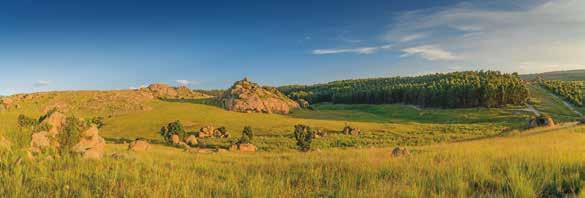
Economic sectors

38
39
42 Energy and efficiency are key for the province’s miners.
48
Sasol partnerships point to a new path.
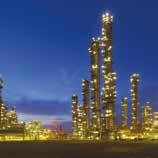
4 MPUMALANGA BUSINESS 2023/24
Mpumalanga Business 2023/24 Edition
Agriculture
and
The macadamia industry is growing fast. Forestry
paper
An agroforestry project plans to convert unused
land. Mining
Oil and gas
Mpumalanga: a world-class tourism destination



Travellers should prepare to be astounded by the natural attractions and experiences that are on offer in Mpumalanga. It is South Africa’s most easterly province, endowed with an extraordinary richness of natural beauty from canyons and waterfalls and with scope for a huge diversity of adventures and experiences ranging from encounter-rich game drives to paragliding. Mpumalanga offers a wide array of activities for the active tourist, ranging from abseiling to white-water-river rafting, with fly-fishing, paragliding, mountain biking, bungee jumping, hiking, 4x4 trails and many outdoor adventure activities in between.
Mpumalanga is undoubtedly the ultimate destination in terms of wildlife experience. The Kruger National Park, Manyeleti, Loskop Dam and numerous private game reserves dotted throughout the region offer an exhilarating experience that brings visitors closer to nature. Mpumalanga boasts a conservancy area that is rich with diverse flora and fauna.
The Panorama Route offers spectacular landscapes with attractions like the Blyde River Canyon (third-largest in the world and known as a “green canyon” because of its subtropical vegetation, pictured). The province also boasts majestic waterfalls and high-altitude scenic drives leading to attractions like God’s Window, Bourke’s Luck Potholes and the Three Rondavels.
Mpumalanga’s rich heritage is still largely unexplored but more and more visitors are being exposed to fascinating

For more information:
Email: info@mtpa.co.za and reservations@mtpa.co.za
Website: www.mpumalanga.com
history. The many heritage sites in the area include the Samora Machel monument near Mbuzini and the Barberton Makhonjwa Mountains World Heritage Site (pictured), boasting rock formations dating back more than 3.5-billion years. Other sites not to be missed are the mining village of Pilgrim’s Rest, the Highveld Heritage Route (which abounds with adventurous tales from history), the stone circles of Mpumalanga and Goliath’s footprint to name just a few. Mpumalanga is rich in culture and boasts the Swazi, Ndebele and Shangaan people with icons like Dr Esther Mahlangu who has managed to preserve, package and export the vibrant geometric art of the Ndebele globally.
Bird watchers can have a glimpse of more than 500 different birds endemic to the Kruger National Park or the town of Chrissiesmeer, the centre of South Africa’s own Lake District where four river systems start their journeys across the country.
The small tourist town of Dullstroom is referred to as South Africa’s trout-fishing mecca. Mpumalanga is an ideal sporting destination with several world-class golf courses and the Mbombela Stadium that was built for the FIFA World Cup in 2010 and has subsequently hosted international football and rugby matches. Get off the beaten track and explore the many other tourism offerings of the Mpumalanga Province.
Facebook: Mpumalanga Tourism and Parks Agency | Twitter: @Mtpatourism | Instagram: @mpumalangatourism

A South African province that has everything a tourist could want.











Manufacturing 50 New sectors are arising from the green economy. Transport and logistics 54 The Maputo Corridor is performing well for logistics companies. Tourism 56 A multi-pronged domestic promotion effort is underway. ICT 58 A Mpumalanga coal mine is using 5G. Education and training 60 Digital skills are coming to Mpumalanga. Banking and financial services 62 Banking while shopping is becoming commonplace. Development finance and SMME support 64 The transition to a green economy may bring opportunities. ABOUT THE COVER: Top left, then clockwise: Mpumalanga’s tourist offering is unrivalled, SA Tourism; Citrus, Meri Global Export; Mining, Sasol; Ngodwana Mill, Sappi; Smelter, Yasin HM on Unsplash; A new campus, University of Mpumalanga; Sunflower, Freepik. MPUMALANGA BUSINESS THE GUIDE TO BUSINESS AND INVESTMENT IN MPUMALANGA PROVINCE 2023/24 EDITION WWW.GLOBALAFRICANETWORK.COM WWW.MPUMALANGABUSINESS.CO.ZA JOIN US ONLINE MPUMALANGA BUSINESS 2021/22 THE GUIDE TO BUSINESS AND INVESTMENT IN MPUMALANGA MPUMALANGA BUSINESS 2021/22 EDITION THE GUIDE TO BUSINESS AND INVESTMENT IN MPUMALANGA PROVINCE WWW.GLOBALAFRICANETWORK.COM WWW.MPUMALANGABUSINESS.CO.ZA JOIN US ONLINE MPUMALANGA BUSINESS THE GUIDE TO BUSINESS AND INVESTMENT IN MPUMALANGA PROVINCE 2018/19 EDITION WWW.GLOBALAFRICANETWORK.COM WWW.LIMPOPOBUSINESS.CO.ZA JOIN US ONLINE JOIN US ONLINE WWW.GLOBALAFRICANETWORK.COM WWW.MPUMALANGABUSINESS.CO.ZA 2018/19 MPUMALANGA BUSINESS THE GUIDE TO BUSINESS AND INVESTMENT IN MPUMALANGA A South African province that has everything a tourist could want. Mpumalanga: a world-class tourism destination Travellers should prepare to be astounded by the natural attractions and experiences that are on offer in Mpumalanga. It is South Africa’s most easterly province, endowed with an extraordinary richness of natural beauty from canyons and waterfalls and with scope for a huge diversity of adventures and experiences ranging from encounter-rich game drives to paragliding. Mpumalanga offers a wide array of activities for the active tourist, ranging from abseiling to white-water-river rafting, with fly-fishing, paragliding, mountain biking, bungee jumping, hiking, 4x4 trails and many outdoor adventure activities in between. Mpumalanga is undoubtedly the ultimate destination in terms of wildlife experience. The Kruger National Park, Manyeleti, Loskop Dam and numerous private game reserves dotted throughout the region offer an exhilarating experience that brings visitors closer to nature. Mpumalanga boasts a conservancy area that is rich with diverse flora and fauna. The Panorama Route offers spectacular landscapes with attractions like the Blyde River Canyon (third-largest in the world and known as “green canyon” because of its subtropical vegetation, pictured). The province also boasts majestic waterfalls and high-altitude scenic drives leading to attractions like God’s Window, Bourke’s Luck Potholes and the Three Rondavels. Mpumalanga’s rich heritage is still largely unexplored but more and more visitors are being exposed to fascinating history. The many heritage sites in the area include the Samora Machel monument near Mbuzini and the Barberton Makhonjwa Mountains World Heritage Site (pictured), boasting rock formations dating back more than 3.5-billion years. Other sites not to be missed are the mining village of Pilgrim’s Rest, the Highveld Heritage Route (which abounds with adventurous tales from history), the stone circles of Mpumalanga and Goliath’s footprint to name just a few. Mpumalanga is rich in culture and boasts the Swazi, Ndebele and Shangaan people with icons like Dr Esther Mahlangu who has managed to preserve, package and export the vibrant geometric art of the Ndebele globally. Bird watchers can have a glimpse of more than 500 different birds endemic to the Kruger National Park or the town of Chrissiesmeer, the centre of South Africa’s own Lake District where four river systems start their journeys across the country. The small tourist town of Dullstroom is referred to as South Africa’s trout-fishing mecca. Mpumalanga is an ideal sporting destination with several world-class golf courses and the Mbombela Stadium that was built for the FIFA World Cup in 2010 and has subsequently hosted international football and rugby matches. Get off the beaten track and explore the many other tourism offerings of the Mpumalanga Province. Email: info@mtpa.co.za and reservations@mtpa.co.za Website: www.mpumalanga.com Facebook: Mpumalanga Tourism and Parks Agency Twitter: @Mtpatourism Instagram: @mpumalangatourism For more information: 6 MPUMALANGA BUSINESS 2023/24











Automation is a no-brainer #BusinessDoneBetter with an MTN Business IoT Our connected device platforms provide maximum remote control, self-activation, real-time monitoring, and self-provision of devices and SIMs. For IoT connectivity, device management, and vertical applications, default to MTN Business. TBWA\HUNT\LASCARIS 940402 Visit mtnbusiness.co.za Email getconnected@mtn.com
Mpumalanga Business
A unique guide to business and investment in Mpumalanga.
Credits
Publishing director:
Chris Whales
Editor: John Young
Managing director: Clive During
Online editor: Christoff Scholtz
Designer: Tyra Martin
Production: Yonella Ngaba
Ad sales:
Gavin van der Merwe
Sam Oliver
Gabriel Venter
Vanessa Wallace
Shiko Diala
Administration & accounts:
Charlene Steynberg
Kathy Wootton
Sharon Angus-Leppan
Distribution and circulation
manager: Edward MacDonald
Printing: FA Print
DISTRIBUTION
The 2023/24 edition of Mpumalanga Business is the 14th issue of this successful publication that since its launch in 2008 has established itself as the premier business and investment guide for the province. Introduced by a warm message of welcome to potential investors from the CEO of the Mpumalanga Economic Growth Agency (MEGA), this edition of the journal also contains the official Mpumalanga Investment Prospectus, a comprehensive survey of the province’s assets and the potential of the region. Major catalytic projects such as the Nkomazi Special Economic Zone (NSEZ) and the Mpumalanga International Fresh Produce Market (MIFPM) are examined in detail, outlining how producers, processors and logistics firms stand to benefit and where there is potential for investment.
In addition to the Prospectus, the journal contains a special feature on how the province is leading the field in going green in various projects across several sectors. Sector overviews give up-to-date news on what is going on in the key sectors of the provincial economy, as well as giving a more general view of conditions pertaining to that sector.
To complement the extensive local, national and international distribution of the print edition, the full content can also be viewed online at www. globalafricanetwork.com. Updated information on Mpumalanga is also available through our monthly e-newsletter, which you can subscribe to online at www.gan.co.za, in addition to our complementary business-to-business titles that cover all nine provinces, our flagship South African Business title and the new addition our list of publications, Journal of African Business, which was launched in 2020. ■
Chris Whales Publisher, Global Africa Network Media | Email: chris@gan.co.za
Mpumalanga Business is distributed internationally on outgoing and incoming trade missions, through trade and investment agencies; to foreign offices in South Africa’s main trading partners around the world; at top national and international events; through the offices of foreign representatives in South Africa; as well as nationally and regionally via chambers of commerce, tourism offices, airport lounges, provincial government departments, municipalities and companies.
Member of the Audit Bureau of Circulations
COPYRIGHT | Mpumalanga Business is an independent publication published by Global Africa Network Media (Pty) Ltd. Full copyright to the publication vests with Global Africa Network Media (Pty) Ltd. No part of the publication may be reproduced in any form without the written permission of Global Africa Network Media (Pty) Ltd.
PHOTO CREDITS | Airlink; Canyon Coal; CHIETA; COFCO International; ENERTRAG; Eskom; Exact; Julie Olivier; University of Mpumalanga; Unsplash; Pan African Resources; Pexels; SAMAC; Sanral;
PUBLISHED BY
Global Africa Network Media (Pty) Ltd

Company Registration No: 2004/004982/07
Directors: Clive During, Chris Whales
Physical address: 28 Main Road, Rondebosch 7700
Tel: +27 21 657 6200 | Fax: +27 21 674 6943
Email: info@gan.co.za | Website: www.gan.co.za
ISSN 2222-3274
DISCLAIMER | While the publisher, Global Africa Network Media (Pty) Ltd, has used all reasonable efforts to ensure that the information contained in Mpumalanga Business is accurate and up-to-date, the publishers make no representations as to the accuracy, quality, timeliness, or completeness of the information. Global Africa Network will not accept responsibility for any loss or damage suffered as a result of the use of or any reliance placed on such information.
Sappi; Seda; SCATEC: Standerton Mills; Terragrn; UNESCO, Unsplash.
FOREWORD
Kruger Lowveld Chamber of Business and Tourism
The voice of business in Ehlanzeni.

As the official representative body of business and tourism in the Kruger Lowveld (Ehlanzeni District), our main mandates are to promote the region as a tourism and investment destination, to provide a diverse suite of networking and marketing opportunities for our members, and to represent and speak on behalf of the business and tourism community of our area. We do this by building and maintaining meaningful relationships with all spheres of government as well as like-minded organisations, and by acting as liaison between these entities and the business community. KLCBT’s president is Professor David Mabunda (pictured).
Area of operation
The Kruger Lowveld covers the Ehlanzeni District of Mpumalanga, including the following local municipalities: City of Mbombela, Thaba Chweu, Nkomazi and Bushbuckridge, as well as the southern part of Kruger National Park and the surrounding private nature reserves.
Member benefits
Listing on website, Pay-to-Play participation in various marketing services and projects, weekly newsletter, invitations to all KLCBT events, advocacy and representations made by KLCBT on behalf of members, access to preferential arrangements negotiated by KLCBT with service providers, brochure display at Crossing Centre office, various sponsorship options, access to tender information. We are actively involved in the following advocacy campaigns:
Service delivery:
Public participation in various forums where government engages with stakeholders regarding budgets, planning and legislation. Promote home-grown businesses through education processes, research, maintaining a database, lobbying for stricter regulations
Contact details
Physical address: KLCBT House, Crossing Centre, Nelspruit
Postal address: Private Bag X 11326, Nelspruit 1200
Tel: +27 13 755 1988 Fax: +27 13 753 2986
Email: business@klcbt.co.za and tourism@klcbt.co.za

Website: www.klcbt.co.za
on large shopping chains, engaging large chains to buy local and to spend their CSI budgets locally.
Local Economic Development: We are assisting with incubation in seven main corridors, mainly adding additional tourism products.
Anti-corruption: Several successful initiatives reduced roadside corruption.
Water: Bulk-water supply faces a future crisis and lobbying for the increase of storage capacity is beginning to show success.
Roads and public attractions: Require upgrades and investment.
Safety and security: A concern for all regions in SA. ■
Professor David Mabunda
MPUMALANGA BUSINESS 2023/24 9
Ensuring success for local businesses in all spheres
By Kagiso Moncho, General Manager: Northern Region, MTN Business

addition to expanding our network, MTNSA is investing R1.5-billion to ensure availability and resilience in the face of persistent loadshedding.
The MTN network is at the heart of all our ICT solutions, enabling organisations of all sizes and from all sectors to continue growing. Augmented by the ongoing rollout of our 5G network, our comprehensive solution stack helped public and private sector organisations enhance their operations over the past year, and 2023 has already seen local companies using technology to find new ways to do things to accommodate for the challenges they are facing in their industries.
Network improvements
When it comes to South Africa’s economic growth, most people don’t think of the Northern Region. However, Mpumalanga is home to some of the country’s most vital industries. From mining, to manufacturing, agriculture, the bulk of our power infrastructure, Mpumalanga helps keep the country running effectively while producing around 7.6% of our GDP.
Unfortunately, our region has its fair share of challenges, but MTN is proud to be able to say that we are actively investing in solutions that we hope will help overcome some of them. In
The improvements we are making to our network – and through those, to all of our offerings – are the latest step towards achieving MTN’s Ambition 2025: To provide leading digital solutions for Africa’s progress. As an important region that is part of the six that make up MTN South Africa’s focus areas, Mpumalanga is front and centre of how we are approaching the digital future.
As MTN’s 5G network and IoT ecosystem grows, this province will come to be a technology leader. Already, local mines and farms are looking at different ways that sensor-connected systems can help make them more efficient and we are leveraging our capabilities and partnerships to help them create roadmaps to achieve their goals.
SMMEs, which are the bedrock of South Africa’s economic growth, are also turning to technology to stay competitive. We believe that SMMEs should have access to the same kind of support that large organisations do, and MTN is proud to be assisting
10 MPUMALANGA BUSINESS 2023/24
MESSAGE
local SMMEs with their technology requirements, whether that is access to affordable connectivity solutions, cloud services like Microsoft Teams and Office 365, or access to digital financial services.
MTN has been helping facilitate payments in Mpumalanga for many years, providing small businesses with an easy way to send and receive money. Mobile Money continues to grow, with millions of people in the region using it on a daily basis.

When the going gets tough, the tough get our support
MTN has long been the supplier of choice for the public sector in the Mpumalanga Province, and our focus will remain on helping government agencies improve their service delivery in 2023. We already have existing long-term relationships with the Department of Education and the Department of Health, along with many municipalities, and are looking forward to growing those partnerships in the future.
We have implemented plans to enable better access to connectivity in rural areas, further assisting service delivery mandates in the Mpumalanga Province, not to mention helping more people access the tools they need for modern connected life. To that end, we have ramped up investment into preventative measures to ensure the resilience of the network.
In addition to loadshedding, the MTN network has to contend with the threats of vandalism and copper theft. We have therefore taken a holistic approach to improving network availability.
This includes investment into, and deployment of, additional backup battery and generator capacity, as well as power contingencies such as 24x7x365 monitoring and response to ensure there is no downtime. MTN has also implemented software-defined power-saving features on base stations during higher stages of loadshedding to ensure 100% availability.
MTN is also embarking on strategic and tactical plans to reduce reliance on the Eskom power grid so that future bouts of loadshedding won’t impact service availability. These plans include the implementation of bespoke solutions that
are less reliant on traditional network topologies, collaboration with strategic partners to offer additional resilience and increased network capacity to cater for the increase in demand during loadshedding periods. We are also accelerating fibre distribution and optimising existing fibre routes.
As local businesses continue to deal with the impact of loadshedding, not to mention having to find solutions to help them stay ahead in a challenging economic environment, MTN is proud to be able to provide the support and relief they need to remain competitive. Mpumalanga will continue to be strong a focus area for us in the year ahead, and a long time to come. This is why our local team, led by Basil Ntlatleng, is dedicated to enabling Mpumalanga’s business community in the face of ever-changing consumer and market trends.
Meet Basil Ntlatleng
Boasting extensive cross-functional business and technology experience in a fast-moving industry with rapidly changing business requirements and technologies, as well as experience in servicing private and public sector customers locally and internationally, Basil Ntlatleng has over 20 years’ experience within the Information and Communications Technology (ICT) sector in Sales and Regional Management, Business Development and Team Leadership across the globe.
Basil is driven to help his team meet and exceed customer-acquisition and revenuegrowth targets by keeping the company competitive and innovative. He is committed to gaining a deep understanding of customer needs, expectations and pain points to optimise business growth. With ever-changing consumer and market trends, he steers diverse operational areas and provides strategic solutions to complex organisational challenges across Large Enterprise, Public Sector and SMME as well as MTN’s Branded Retail Channel, BRC. ■
Email: Basil.Ntlatleng@mtn.com
11 MPUMALANGA BUSINESS 2023/24
MESSAGE
MPUMALANGA PROVINCE
The transition away from coal and other fossil fuels presents a huge challenge but in Mpumalanga a series of innovative and bold partnerships is tackling the task head on. South Africa’s biggest wind farm project has also begun in the province previously known for coal and power stations.
 By John Young
By John Young
Partnerships are springing into being in every sector of the economy. Whether they are between government agencies, research institutes or between local and international companies, collaboration is all the rage.
And the province of Mpumalanga is leading the way. With Mpumalanga’s economy being so strongly geared towards coal (in mining and for energy generation) it makes sense that actors in a variety of sectors should be finding ways to work together to transition to a greener future.
At national level, President Ramaphosa was an invited guest in June 2023 to the Summit for a New Global Financing Pact in Paris, partly at least
because South Africa is partnering with several European countries and international institutions in green financing arrangements. Various other countries are taking their lead from the Just Energy Transition Partnership whereby South Africa will get $8.5-billion in financing provided by France, Germany, the United Kingdom, the United States and the European Union.
Separate to that deal, the prime ministers of the Netherlands and Denmark came to South Africa to sign an agreement to start a green hydrogen fund to be known as the SA-H2. Concession funding from the Netherlands will also be made available for water and energy infrastructure while
12 MPUMALANGA BUSINESS 2023/24 A REGIONAL OVERVIEW OF
The Sand River flows through the Sabi Sand Nature Reserve before joining the Sabie River in the Kruger National Park. Credit: Julie Olivier
Mpumalanga’s Grootvlei power station, earmarked for closure or conversion, will be the site of a pilot project focussed on growing food in greenhouses, hopefully providing jobs for those who lose their jobs related to coal.
Sasol is engaging in new partnerships with increasing frequency, as outlined in some detail in the Oil and Gas sector overview in this journal. From green hydrogen to sustainable aviation fuel (SAF), South Africa’s biggest chemicals and energy company is signing agreements with Germans and Danes while cooperating with entrepreneurial technical startups out of Oxford University.
The field is ripe for innovation and partnerships are speeding up the process of discovery. MTN, Huwaei and Minetech Smart Mining are working together in a 5G pilot project at an Mpumalanga coal mine.
Even in winding down old resources, partnerships have been chosen as the preferred method. A Mine Water Coordinating Body (MWCB) has successfully been launched to help manage the after-effects of the closure of mines and power stations. Many of Mpumalanga’s coal-fired power stations are either in the process of being closed or will shortly be shut down and the same is true of some coal mines that have reached the end of their lives. Eskom, together with mining houses Exxaro, Glencore and Thungela Resources, formed the MWCB to address environmental and socioeconomic challenges that might arise.
Issues such as water also fall under the ambit of a broader mine-industry related coalition known as the Impact Catalyst which has been launched in Mpumalanga.
Local green moves
The Provincial Government of Mpumalanga has established the Mpumalanga Green Cluster Agency to bring together government, academia and industry to create the environment for businesses to develop in a green economy.
The Cluster, an initiative of the Mpumalanga Department of Economic Development and Tourism with the support of GreenCape and the Deutsche Gesellschaft für Internationale Zusammenarbeit (GIZ), has joined the International Cleantech Network, a group that has 15 000 businesses affiliated to it across the globe.
National utility Eskom is also moving into the new era, partly through a process whereby the entity will be broken into three more competitive units, but more immediately through the announcement of 18 winning bids from independent power producers (IPPs) for renewable projects on Eskom land, 4 000ha of which the utility has made available for this first phase. Eskom owns 36 000ha in the province. A total of 1 800MW will become available to the grid and it will be cheaper to transmit because the solar or wind plants will be right next to the existing Eskom transmission lines.
Ten coal plants are due to be closed by 2040, with four Mpumalanga plants (Hendrina, Grootvlei, Camden and Komati) first in line. Eskom is undertaking studies to assess the potential impact on local communities of these closures. Options to get these plants producing energy again include gas, biomass and hydrogen but it is possible they might be used for something quite different. Eskom wants to be a net-zero company by 2050.
National government’s Renewable Energy Independent Power Producer Procurement Programme (REIPPPP) has seen the investment into this totally new sector of more than R200-billion since 2012 and South Africa is now home to 112 IPPs, whereas just 12 years ago there were fewer than 40 in Sub-Saharan Africa.
The relaxation by national government of the rules regarding setting up a power plant of 100MW or less is well suited to the requirements of big timber-processing companies such as Sappi and PG Bison and all the large mining concerns that are active in Mpumalanga. Sappi is a partner in a 25MW biogas energy facility at it Ngodwana Mill.
Investment options
Several infrastructure investment projects in the tourism sector have been put forward by the Mpumalanga Economic Growth Agency (MEGA). There is a special focus on BRICS countries and the province was glad to welcome the announcement of a new flight into Kruger Mpumalanga International Airport in 2022 by the tourist division of Lufthansa, Eurowings Discover. The TRILAND partnership with Eswatini and Mozambique is another avenue, as is the collaboration with KwaZulu-Natal, Eswatini, Mozambique and the Seychelles.
13 MPUMALANGA BUSINESS 2023/24
SPECIAL FEATURE
MEGA is an equity investor in a number of Mpumalanga concerns, including Afrimat, Highveld Fruit Packers, Kangwane Anthracite, Loopspruit Winery and Tekwane Lemon Farm.
In the Nkangala District Municipality, a publicprivate partnership is due to deliver a hotel and conference centre in the town of Middelburg in the Steve Tshwete Local Municipality. It may seem ironic that R350-million is to be spent on a Radissonbranded hotel in the aftermath of Covid-19 but conferences and tourism will return.

Elsewhere, mining and timber companies are making large investments in increased production or in extending the life of mines.
A major concern for provincial planners is to diversify the economy and to grow the manufacturing sector. The Mpumalanga Economic Growth and Development Path (MEGDP) identifies beneficiation, agro-processing and the development of value chains as priorities. Various industrial parks are planned which will focus on agriculture and forestry, mining and metals and petrochemicals. An International Fresh Produce Market in Nelspruit and the planned Nkomazi SEZ (Special Economic Zone) are other priorities.
Steel and associated manufacturing remains one of the province’s strong suits and Mpumalanga has rich and varied mineral resources and fertile soil that support diverse farming operations,
agriprocessing and forestry. The province also hosts large companies in the manufacturing sector such as Middelburg Ferrochrome and the Manganese Metal Company.
The province’s rich agricultural produce is used by companies such as McCain, Nestlé and PepsiCo and there are also pulp and paper plants (Sappi and Mondi), with PG Bison set to start producing more than 1000m³/d per annum at its Mkhondo particleboard plant after two investment injections of R600-million (on a press and forming line) and R560-million (on a front-end dryer).
York Timbers is another forestry company and the sugar mills and refinery of RCL Foods (formerly TSB Sugar) along with fertiliser facilities and textile manufacturing concerns are all contributors to the provincial economy.
The southern half of the eastern limb of the platinum-rich Bushveld Igneous Complex runs south towards the towns of Lydenburg and Machadodorp. Deposits of chromite, magnetite and vanadium in this area are the basis of the ferro-alloy complex in Witbank-Middelburg and Lydenburg.
The town of eMalahleni is the centre of the coal industry. Other minerals found in the province include gold, platinum-group minerals, chromite, zinc, cobalt, copper, iron and manganese.
Middelburg is home to Columbus Stainless, South Africa’s only producer of stainless steel, and several big engineering works. It is about 130km from Pretoria and less than three hours’ drive from the Malelane Gate of the Kruger National Park.
The Kruger National Park remains the province’s most-visited asset but the decision by UNESCO to afford World Heritage Site status to the Makhonjwa Mountains near Barberton will boost geological tourism to the province and supports the efforts of the province to diversify its offerings. Major projects to improve tourist experiences are underway at the Graskop Gorge (where a transparent lift takes tourists into the depths of the gorge), a Skywalk is to be built at God’s Window and a cable car is planned for Three Rondavels.
The international body’s decision has also had the effect of expanding the curriculum at the University of Mpumalanga. On the basis of the UNESCO ruling, UMP has a new offering in geology as part of a BSc degree. ■
14
MPUMALANGA BUSINESS 2023/24
The University of Mpumalanga is offering degrees relevant to its citizens as it expands.
MPUMALANGA TRADE & INVESTMENT PROFILE

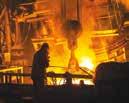







MPUMALANGA IS OPEN FOR BUSINESS THE PLACE OF THE RISING SUN
WHY INVEST IN MPUMALANGA?
• 68% of land area in the province is used by agriculture

• Mpumalanga’s three biggest sectors are manufacturing, mining and agriculture
Mpumalanga’s diverse and resource-rich economy makes it one of the most attractive trade and investment destinations in South East Africa.
A large, growing domestic market and excellent access, supported by worldclass infrastructure, to the East African and Indian Ocean markets through Maputo Port makes Mpumalanga an ideal investment location for export-driven manufacturing and production.
Mpumalanga is one of South Africa’s most productive and important agricultural regions and through strategic investments in the Mpumalanga International Fresh Produce Market (MIFPM) and the Nkomazi Special Economic Zone (NSEZ) the province is set to become a major force in food production and distribution.
Mpumalanga’s sophisticated and well-segmented tourism and hospitality sector in a post-Covid world is ripe for investment and expansion.
Mpumalanga’s STRATEGIC LOCATION makes it a valuable transport and logistics hub
A province in eastern South Africa, bordering the nations of Swaziland and Mozambique
• Maputo Development Corridor enhances logistics
• Preferential access to lucrative EU market
• Proximity to South Africa’s economic heartland
• Access to regional SADC market: 360-million population
• Access to deepwater Port of Maputo
MPUMALANGA’S ECONOMY
UNIQUE SELLING PROPOSITION
•Abundant resources: minerals and agricultural produce
• Established manufacturing infrastructure: smelters, petrochemicals, food processing, paper, sugar
• Strategic location, access to regional and global markets
• Tourism hotspots: the iconic Kruger National Park, world-class reserves, adventure tourism and new UNESCO World Heritage Site
• Mpumalanga International Fresh Produce Market (MIFPM)
• Nkomazi Special Economic Zone (NSEZ)
• The new University of Mpumalanga
• Support for Green Economy research and investment
The provincial economy of Mpumalanga is exceptionally diverse. Established industries in the province include Mining, Stainless Steel, Petrochemicals, Pulp and Paper, Ferro-Alloys, Energy Generation, Tourism, Agriculture and Agro-Processing.
Companies in these sectors include global giants in their industries such as Sasol (energy and chemicals), Sappi (paper, packaging, pulp and forests), Samancor Chrome (ferrochrome), Sibanye-Stillwater and Glencore (mining).
District
Middelburg Secunda
by district
38% 34%
28%
The province’s commercial farmers are among the most efficient in the world, exporting huge quantities of everything from citrus to macadamia nuts. Columbus Stainless is the only stainless-steel manufacturer on the continent.
GOVERNANCE
The province has three district municipalities and 17 local municipalities. Several agencies which promote the regional economy report to the Mpumalanga Provincial Government. Large parts of the province comprises extensive rural villages that form part of areas run by traditional authorities.

TRANSPORT
Two airports at Hoedspruit and Mbombela (Kruger Mpumalanga International Airport, KMIA) plus many airfields. Extensive freight rail network, busiest in South Africa. N4 highway (Maputo Corridor) is an east-west spine of a highly-developed road system.
Mpumalanga
Capital City Mbombela (Nelspruit)
Population 4.5-million people Main major towns Ermelo eMalahleni
AGRICULTURE 3% MANUFACTURING 15% TRANSPORT 6% FINANCE 14% CONSTRUCTION 2% COMMUNITY SERVICE 19% ELECTRICITY 7% TRADE 14% MINING 20%
Gert Sibanda Ehlanzeni
GVA
Nkangala
Airport Kruger Mpumalanga International Airport
ABOUT MEGA
The Mpumalanga Economic Growth Agency (MEGA) is the official Economic Development Agency for the Mpumalanga Provincial Government.
MEGA’s primary mandate is to foster the sustainable growth and development of Mpumalanga’s economy through its operational activities of Trade and Investment Promotion, Development Funding, Equity Investments, and Property and Infrastructure Development. The Agency remains accountable to the Mpumalanga Department of Economic Development and Tourism (DEDT). MEGA is the foreign investor’s or trader’s first point of contact for doing successful business in Mpumalanga Province. Through the Trade and Investment Promotion Division, the Agency provides a variety of services to potential investors and trading partners.
MEGA SERVICES
MEGA staff will go out of their way to make the process of investing in Mpumalanga or starting a business in the province easy. MEGA is focussed on customer needs and provides innovative solutions with a high level of service. Services include:

• Foreign Trade Promotion
• Investment Promotion
• Funding
• Property Management and Infrastructure Development
PLANNING THE WAY FORWARD
National government has articulated a Nine-Point Plan which seeks to prioritise projects that will tackle key economic issues. MEGA is aligned with the plan, which include issues relevant to growing the provincial economy:
• revitalise agriculture and the agro-processing chain
• advancing mineral beneficiation

• implementing the Industrial Policy Action Plan (IPAP) effectively

• unlocking the potential of SMMEs, cooperatives and township and rural enterprises
• resolving the energy challenge
• stabilising the labour market
• upscaling private investment
• investment in science and technology, water and sanitation, transport and broadband connectivity
MAPUTO DEVELOPMENT CORRIDOR
The Maputo Development Corridor is South Africa’s leading Spatial Development Initiative (SDI), linking Mpumalanga Province, Gauteng Province and the Nkomazi Special Economic Zone with the deepwater Port of Maputo in Mozambique. This efficient corridor provides investors and exporters with good access to the export markets of South East Africa, the Indian Ocean Rim and Far East Asia. The Maputo Development Corridor comprises road,
SOUTH AFRICA
rail, Special Economic Zone, border posts, port and terminal facilities. The corridor runs through the most highly industrialised and productive regions of Southern Africa. The Corridor has been extensively upgraded to international standards and links the industrial heartland of South Africa to its nearest port in Maputo, Mozambique, which is one of the fastest-growing countries in South East Africa.
JOHANNESBURG SWAZILAND Lydenburg Middelburg Mbombela Belfast Carolina Sabie Komatipoort MOZAMBIQUE
MAPUTO
KEY SECTORS AGRICULTURE
Agriculture in Mpumalanga is responsible for 3% of the province’s gross value added by region (GVA-R) and can be divided into the following categories (see map, right).
AGRICULTURE
SUMMER CEREALS & LEGUMES
MAIZE Maize meal
SOYA Meal, Edible oil
CANOLA Edible oil
SUNFLOWER Edible oil
TROPICAL & SUBTROPICAL FRUIT
CANE SUGAR Sugar / confectionery
CITRUS Juice & concentrate
MANGOES Dried, frozen, juice & concentrates
LITCHIS Dried, frozen, juice & concentrates
AVOCADOES Avocado oil
GUAVA Dried, frozen, juice & concentrates
MACADAMIA NUTS
Processed & confectionery
Mpumalanga Province is one of South Africa’s most productive and important agricultural regions and plays a key role in the export profile of South Africa, primarily in fruit and nuts. The province’s economic diversity extends into the agriculture sector where the natural topography of the province divides this sector between the Highveld and Lowveld Regions.
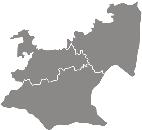
The Highveld Region in the west of the province is at an elevation of between 4 000 and 6 000 feet above sea level. This allows for the large-scale and commercial production of cereals and legumes like maize, soya, canola and sunflower.
The subtropical region of the Mpumalanga Lowveld plays a key role in the agricultural export profile of the province, primarily in fruit and nuts.
Mpumalanga Province is one of the world largest producers and exporters of citrus fruit. Duty-free exports of South African citrus to the USA under the African Growth and Opportunity Act (AGOA) reached a peak of 91 000 tons in 2020 ($94.9-million) and are expected to continue their strong annual growth as the USA is still considered a premium market.
KEY SECTORS FORESTRY
Lowveld Highveld
HIGHVELD: Summer cereals and legumes: maize, soya, canola, sunflower. Animal products: bovine meat, swine, sheep and poultry.
LOWVELD: Subtropical and citrus fruits, nuts and cane sugar.
Mpumalanga Province is the world’s largest producer and exporter of macadamia nuts. The province earned $207-million in exports in 2019, $76-million of this to the US. There have been major new investments in processing facilities in Mpumalanga.
Mpumalanga’s rich agricultural produce is utilised by companies such as McCain, Nestlé and PepsiCo.
9:1
Mpumalanga’s ratio of commercial farmers to small-scale farmers
Forestry is a key driver for the development of Mpumalanga’s rural economy and a major provider of job opportunities. About 40% of SA’s sustainable forests are located in Mpumalanga Province.
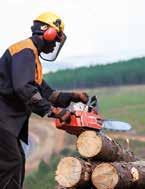
The industry comprises logging, saw-milling, wood products, wood board, pulp and paper as well as specialised cellulose. Specialised cellulose is a sought-after natural, renewable fibre with a wide range of uses in the textile, consumer goods, foodstuff and pharmaceutical industries and is produced in large quantities at Sappi Ngodwana.
R9.5 billion Amount invested in the foresty industry
39
Mpumalanga has processing plants out of 148 in South Africa
PG Bison has recently invested R560-million in a new front-end dryer for its particleboard plant in Mkhondo (Piet Retief). The company is also building a new medium-density fibreboard (MDF) plant at its Mpumalanga plant.
SAFCOL/Komatiland is the state forestry company with commercial and non-commercial operations covering a land area of 187 320ha.
Sonae Arauco is a Portuguese investment. A new entrant, local BEE company the FX Group, is commissioning a greenfield particle board plant in Lothair in the Gert Sibande District.
MAIN EXPORTS
PULP
PAPER
SPECIALISED CELLULOSE
SAWN LUMBER
WOOD CHIPS
WATTLE EXTRACT
MAJOR COMPANIES
SAPPI
SAFCOL
SONAE ARAUCO
PG BISON
REGIONAL PRODUCE
YORK TIMBERS FX GROUP
KEY SECTORS MINING, MINERALS AND ENERGY
Mining is the province’s largest single sector, providing employment to 5.2% of the province’s workforce and making up 20% of gross value added by region (GVA-R).
Coal: 83% of South Africa’s coal production, 50% of national coal reserves, third-largest coal-exporting region in the world. Coal is the lifeblood of provincial economy, fuelling 11 Eskom power plants, which produce 80% of South Africa’s electricity. Coal is Mpumalanga’s single largest export product, shipping mainly to India and Pakistan.
of South Africa’s coal production
Other minerals: Gold mining takes place in Evander, Pilgrim’s Rest and Barberton. Gold is the second-largest export from the province. Platinum and chrome ore mining are located in the Steelpoort and Burgersfort areas in the north of the province and make up part of the Bushveld Igneous Complex.
The mining services and technology industry is an important subsector in Mpumalanga. With over a century of commercial mining operations in the province, homegrown technologies are now exported around the globe.
National utility Eskom will spend R3.3-billion on the revival of the Matla coal mine. Exxaro Resources will manage the project and do the mining while major companies such as DRA, Worley, Sandvik and WBHO will also be involved.
Other companies engaged in expansion of life-of-mine projects are Pan African Resources and Evander (Elikhulu tailings), Exxaro Resources (Leeuwpan) and South32, which is spending about R4.3-billion at Klipspruit.
Platinum is an important mineral for the modern economy. Two Rivers is a joint venture between Implats (46%) and African Rainbow Minerals which is located on the southern part of the eastern limb of the Bushveld Igneous Complex, 35km south-west of Burgersfort in Mpumalanga.
Lydenburg is home to the Lion ferrochrome smelter that is a joint venture between Glencore and Merafe Resources.
KEY SECTORS GREEN ECONOMY AND JET
Mpumalanga has historically been at the heart of the South African energy and industrial complex and is still heavily reliant on the mining and burning of fossil fuels.
The Mpumalanga Provincial Government has been proactive in exploring opportunities in the Green Economy and pursuing a just transition to a low-carbon economy which secures the future and livelihoods of workers and their communities. Achieving such a just transition would require an integration of economic opportunities in sectors outside of energy and mining.
A Just Energy Transition (JET) to a Green Economy presents the following opportunities:
• Renewable energy: solar, biomass, natural products
• Gas and associated industries
• Sustainable smart agriculture: environmentally-friendly agriculture and agricultural processing
• Circular Green Economy: waste recycling, water reclamation, land rehabilitation
• Soft infrastructure: reskilling and institutional capacity-building for a carbon-neutral future
• Hard infrastructure: investment and expertise are needed in urban planning, water and waste management
• Building technologies: greener and more energy-efficient
• Transport and logistics: greener and more energy-efficient
MINERALS
COAL
GRANITE Building cladding & tombstone
CLAY
50% of South Africa’s national coal reserves
Specific opportunities include:
•There are plans for the decommissioning of 11 000MW of Eskom’s coal-fired capacity by 2030. Opportunities are presented by repurposing land.
• The vast new fields of natural gas found off the coast of Mozambique could have a big impact on the Mpumalanga economy.
• A Renewable Energy Development Zone (REDZ) is planned for eMalahleni / Witbank where coal jobs are at risk.
83%
11
Mpumalanga has ESKOM POWER plants
Waste briquettes GOLD JEWELLERY CHROME PLATINUM IRON ORE VANADIUM MANGANESE
Porcelain & ceramics
Electrical insulators
KEY SECTORS MANUFACTURING
Three primary pillars of the manufacturing sector in Mpumalanga account for more than 60% of the output of the manufacturing sector, which overall makes up 15% of gross value added, regional (GVA-R).
MAIN EXPORTS
STAINLESS STEEL
Cutlery
Catering equipment
Surgical instruments
Automotive components
STEEL White & grey goods
Pipes & tubes
Wire
PETROCHEMICALS
Plastic products
Recycling plastics
Artificial rubber products
Paint & vanish
Inks & dyes
FOOD PROCESSING
Maize meal
Machinery
Frozen & dehydrated
VEGETABLES Preserves, pickles & condiments
Nuts
PAPER Recycling
SUGAR Confectionery
MINING Machinery and services
RENEWABLE ENERGY
Solar and biofuel
Biomass
Fuel, petroleum and chemical products are manufactured at the Sasol Secunda plant in Secunda, Gert Sibande District. It is one of the world’s largest synthetic fuels facilities, producing 60-million litres of liquid fuel a day. Products produced include petroleum, paraffin, jet fuel, creosote, bitumen and waxes.
The ferro-alloy and stainless-steel industries are based in the Nkangala District. Columbus Stainless in Middelburg is Africa’s only producer of stainless-steel flat products. Samancor Chrome (Ferrometals), the world’s second-largest ferrochrome producer, has two plants in Mpumalanga.
Agro-processing is mainly based in the Lowveld Region and consists of manufacturing forestry products (pulp, paper and cellulose), sugar at the Selati RCL Foods plants in Nkomazi and processing subtropical fruit and nuts.
The province’s flourishing macadamia nut industry has a number of large processing facilities based around the provincial capital Mbombela. Subtropical fruits like mango, banana, papaya and citrus are processed into juice concentrate or dried for export.
There is a geographical divide in the manufacturing sector. Fuel, petroleum and chemical production occurs in the southern Highveld Region clustered around Sasol’s plants.

The northern Highveld area, including Middelburg and eMalahleni (Witbank), is home to ferro-alloy, steel and stainless-steel concerns. Creative thinking kicked in when Highveld Steel’s troubles reached a tipping point. The 1 000ha property in Emalahleni has been re-purposed as a multi-purpose site for industry and commerce. Called the Highveld Industrial Park, the project promotes a wide range of manufacturing enterprises.
In the Lowveld, agricultural and forestry products are processed while Sappi’s giant mill is close to the company’s forests south-west of the provincial capital, Mbombela.
KEY SECTORS TOURISM
The importance of tourism to the economy of Mpumalanga cannot be overstated. The effect of the Covid-19 pandemic has been strongly felt.
Mpumalanga received only 340 000 international visitors in 2020, down from 1.6-million international visitors in 2019. The key source countries were Mozambique, eSwatini, the USA, Germany, France and the UK. Domestic tourism has steadily increased. The total tourist foreign direct spend (TTFDS) in Mpumalanga for 2020 was R7.5-billion, down from over R21-billion in 2019. The sector accounts for 6% of gross value added by region (GVA-R).
The announcement in 2022 by Eurowings Discover, a new division of Lufthansa, that it would start flying three times a week to Mbombela from Frankfurt, via Windhoek, will give a certain boost to tourist numbers
1.6 MILLION
Number of visitors
ANNUALLY pre-COVID-19
billion
Rand value of tourist spend in Mpumalanga… before COVID-19
visiting Mpumalanga. The Kruger National Park is Mpumalanga’s most famous tourist asset and safaris and hunting are major tourist attractions. The Manyeleti Reserve, a 23 750-hectare game reserve sharing a fenceless border with the Kruger National Park, is operated and managed by the Mpumalanga Tourism and Parks Agency (MTPA). God’s Window and the Blyde River Canyon Reserve are other provincial treasures attracting investment. Business travel, including conferencing, adventure, heritage and cultural tourism, all hold huge growth potential in Mpumalanga, but require investment in infrastructure and product development.
A hotel and conference centre project in Middelburg is making progress and should be completed in 2023.
21
INVESTMENT OPPORTUNITIES TOURISM
Selected Strategic High Impact Projects:
BOURKE’S LUCK POTHOLES HOTEL
This natural water wonder is a major tourism attraction in the Mpumalanga Lowveld. This project presents an investment opportunity for a five-star hotel and a top-quality restaurant.
Feasibility study: completed
Environmental Impact Assessment (EIA): commenced
Model: Joint Venture (JV), Build-Operate-Transfer (BOT)
Value: R100-million
GOD’S WINDOW SKY WALK
The project to build a “Sky Walk” – an income-generating tourism attraction off the edge of the 700m God’s Window cliffs – giving 360-degree panoramic views out and down through a glass floor.
Feasibility study: completed
EIA: commenced
Investors: secured
Model: JV, BOT
Value: R100-million
3.7km
Length of one of Eastgate Airport’s runways at Hoedspruit, which doubles as an airforce base. The other runway is 2.1km
500+
BLYDE RIVER CANYON CABLE CAR PROJECT
The Blyde River Canyon is the largest and deepest green canyon in the world and offers a spectacular opportunity to build a cable car transporting tourists from the top of the canyon to the peninsula below.


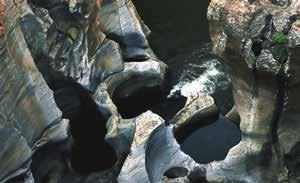
Feasibility study: completed
EIA: commenced
Model: JV, BOT
Value: R500-million
13
Bird species recorded in the Kruger National Park, including the Kori Bustard, Martial Eagle, Southern Ground Hornbill and Lappetfaced Vulture
Nature reserves are run by the Mpumalanga Tourism and Parks Agency and Kruger National Park is run by SANParks
INVESTMENT OPPORTUNITIES PRODUCE MARKET
Selected Strategic High Impact Projects: Mpumalanga International Fresh Produce Market
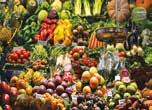
MEGA is establishing a R1.2-billion fresh produce market facility located in Mbombela, the Mpumalanga International Fresh Produce Market (MIFPM). To date the province has invested an estimated R540-million in the project.
Mpumalanga is one of South Africa’s most productive and important agriculture regions. It is home to predominantly tropical and subtropical crops and vegetables owing to its conducive climate. The tropical and subtropical crops consist of avocado, banana, citrus, ginger, granadilla, guava, litchi, macadamia nut, mango, papaya and pineapple.
The vegetables produced include potatoes, tomatoes, pumpkins, sweet corn, onions, sweet potatoes, beetroot, carrots, green peas, cauliflower, cabbages and green beans.
Site: The site is in Mbombela on a 248ha plot less than 10km from the Central Business District. It is situated within the Maputo Development Corridor (MDC), linking Mpumalanga, Gauteng Province and the Nkomazi Special Economic Zone with the deepwater Port of Maputo in Mozambique.
The market: The market will give local farmers access to local, regional and international fresh produce markets and will aid in ensuring food security for the region.
The infrastructure of the MIFPM will attract international as well as the large domestic food retailers as a key processing and distribution
point. It will also secure Mpumalanga’s position in the regional export market in fresh produce.
The market will offer:
• Open trading halls for fruit and vegetables
• A meat, fish and flower market
• Complementary cold storage, ripening facilities and pallet handling
• Processing facilities
• An export hall
• Bulk-breaking facilities for retail outlets
• Links with statutory organisations such as customs, PPEBC and EuroGap

• Transport and logistics enterprises
• Shared collation and pack house facilities for SMMEs
• Commercial services including banks and restaurants
• A food bank for NGOs
Feasibility study: completed
EIA: completed
Bulk infrastructure: completed
Top structures: underway
Model: JV, BOT
Value: R1-billion
INVESTMENT OPPORTUNITIES NKOMAZI SEZ
Selected Strategic High Impact Projects: Nkomazi Special Economic Zone

The Nkomazi Special Economic Zone has been officially designated and MEGA has been appointed to establish the entity.
SEZs are geographically designated areas set aside for specifically targeted economic activities that are supported through special tax incentives. An SEZ aims to be an economic development tool to promote rapid economic growth by using various support measures to attract targeted foreign and domestic investments and technology. The main goal is to support the implementation of South Africa’s industrial development programme.
Strategically positioned in the border town of Komatipoort, the SEZ offers a multi-sector base of operations along the Maputo Development Corridor which provides exporters with good access through Maputo Port to the export markets of South East Africa, the Indian Ocean Rim and Far East Asia.
The Nkomazi SEZ will target investment from the agriculture, agro-processing, nutraceuticals and fertiliser production sectors, as having a strong focus on logistics and trade services.
The NSEZ offers the investor a unique and incentivised base of operations on the Maputo Development Corridor running through the most highly industrialised and productive regions of Southern Africa.
The Maputo Corridor is bound to develop even more as the Maputo harbour improves its handling and scheduling
capacity. In the event that a second rail line to Maputo to complement the current rail link is developed, the shipment of mining products
MPUMALANGA –NKOMAZI
Manufacturing
Centralised Facilities
Convenience Retail Accommodation
Logistics
Recreation
FOREIGN TRADE
Mpumalanga is proving to be a key player in the local economy as well as internationally.


TOP 10 EXPORTS 2022
TOP 10 EXPORT MARKETS 2022

2022/03/23 –NKOMAZI SEZ
1. Ferro Alloys R 35 billion US$ 1.9 billion 2. Coal R 16 billion US$ 913 million 3. Stainless Steel R 9.1 billion US$ 504 million 4. Platinum R 6.9 billion US$ 385 million 5. Gold R 5.8 billion US$ 322 million 6. Macadamia Nuts R 4.1 billion US$ 229 million 7. Chrome Ore R 2.4 billion US$ 138 million 8. Manganese R 2.3 billion US$ 129 million 9. Fuel Wood R 1.5 billion US$ 85 million 10. Citrus Fruit R 576 million US$ 32 million
1. Mozambique R 21 billion US$ 1.6 billion 2. China R 9.5 billion US$ 529 million 3. United States R 8.5 billion US$ 471 million 4. Japan R 5.9 billion US$ 331 million 5. Korea R 5.5 billion US$ 308 million 6. Netherlands R 5.2 billion US$ 291 million 7. India R 3.8 billion US$ 210 million 8. eSwatini R 3.2 billion US$ 180 million 9. UAE R 3.2 billion US$ 178 million 10. Indonesia R 2.4 billion US$ 135 million
THE PERFECT LAUNCH PAD FOR AFRICA
The African Continental Free Trade Area could revolutionise African trade: Mpumalanga is the perfect launch pad for manufacturers and exporters.

start of trading under the AfCFTA Agreement from the beginning of 2021. Further meetings have been held to take the process forward in terms of details and practical measures.
The nations covered by AfCFTA have an estimated combined GDP of $2.5-trillion and a population of over 1.2-billion.
In terms of population, it will be the largest free trade area in the world. The AfCFTA envisages the
The African Continental Free Trade Area (AfCFTA) has been agreed on by almost all African nations and holds the potential to change the nature and size of trading on the continent in profound ways.

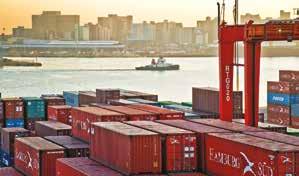
Mpumalanga Province, as a strategically-positioned region with a dynamic manufacturing sector and excellent logistics and infrastructure, provides the perfect launch pad for investors looking to take advantage opportunities that will be created by the AfCFTA Agreement.
The burgeoning African middle-class is a global trend that economists are carefully watching. As more sophisticated infrastructure is rolled out across Africa, having a base with good connections to ports and with good air, road and rail connectivity will be vital. Mpumalanga has all of that, and more.

An Extraordinary Summit of the AU Assembly on the AfCFTA was held in December 2020. The Assembly approved the
gradual elimination of tariff and non-tariff barriers to trade on the continent. In terms of export-driven manufacturing and production Mpumalanga is well positioned to take full advantage of the economic promise of the AfCFTA and attract investment, thereby helping to increase income levels and reduce poverty. Mpumalanga is served by the Maputo Development Corridor (MDC), which is South Africa’s leading Spatial Development Initiative (SDI), linking Mpumalanga, Gauteng Province and the Nkomazi Special Economic Zone with the deepwater Port of Maputo in Mozambique. This strategic location gives Mpumalanga a particular advantage with respect to logistics and market access.
Improving and increasing intra-African trade will change the way countries do business and include a much broader range of countries and products into the global market. Foreign direct investment is expected to grow rapidly, as investment opportunities such as those on offer in Mpumalanga attract the attention of international companies and institutions. New sectors, such as the Green Economy which Mpumalanga is actively preparing for, will grow exponentially on the back of a continental system of trade with fewer barriers and more connections than ever before.
Instrument of ratification deposited Parliamentary approval received or pending AfCFTA Agreement signed AfCFTA Agreement not signed
Af CFTA FAST FACTS
Africa’s exports could increase by $560-billion and some experts predict that continental business and consumer spending could reach $6.7-trillion by 2030.

$450 BILLION
AfCFTA could boost regional income by 7% or $450-billion
(Source: the World Bank)
30
AfCFTA could lift -million people
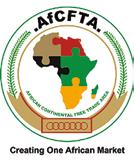
out of poverty, according to the World Bank
10% AfCFTA could boost wages by up to
* World Bank estimate
ABOUT SADC
South Africa is a member of one of Africa’s oldest regional organisations, the 16-member Southern African Development Community, (SADC). This enables duty-free trade within a growing market of more than 360-million people. All goods shipped under SADC Certificate of Origin receive duty-free status.

Duty-free trade
within a GROWING MARKET of more than360 million people
Going green
Mpumalanga is famously fertile, but it’s a different kind of green that is changing the energy landscape of South Africa’s biggest power producer.
Awind farm under construction in Mpumalanga in the heart of coal-mining country is an outstanding example of thinking outside the box. The project will use renewable energy to provide power to coal mines.
All over Mpumalanga, companies, agencies, government departments and researchers are finding ways to go green.
The renewable energy subsidiary of coal-mining company Seriti Resources, Seriti Green, is to build a 150MW wind farm that will allow the company to receive 75% of the energy it needs to run its coal mines from renewable sources. This first phase of a larger project is expected to start producing power in 2025.

Seriti Green acquired a majority share of renewable energy asset manager Windlab in December 2022 for R892-million. The wind farm will cost R4-billion, with R1.5-billion allocated to new grid infrastructure. The grid infrastructure will be partly owned by national utility Eskom.
A power-purchase contract has been signed between the two Seriti entities, environmental authorisation has been granted by the Department of Forestry, Fisheries and the Environment and Standard Bank and RMB have signed the financing agreements.
Seriti Green has its eyes on developing 3 000MW of wind and solar in the next ten years. Seriti’s first wind farm is part of a larger plan for the area between Bethal and Morgenzon in the Gert Sibande District Municipality, namely a 900MW renewable energy cluster comprising both wind and solar power.
This will be known as the Ummbilla Emoyeni Renewable Energy Farm. Given the strategic importance of the coalfields and power stations of Mpumalanga, the Department of Public Works and Infrastructure has designated the project a Strategic Integrated Project.
Once the larger project is fully developed, there will be
26
MPUMALANGA BUSINESS 2023/24
Seriti Green is to construct a giant windfarm complex in Mpumalanga. Credit: Appolinary Kalashnikova on Unsplash
111 turbines, each of which will require two days of scheduled maintenance every year. Venn stated that his company would invest between R20-billion and R30-billion into the greater Ermelo region over the next five years. It is in these statistics that it becomes clear that the transition to clean energy will indeed create new jobs.
Mpumalanga advantage
One of South Africa’s most successful investment projects, the Renewable Energy Independent Power Producer Procurement Programme (REIPPPP), suffered a setback in the period between 2015 and 2021. It has since been relaunched and investors are queuing up to take a stake in greener energy but South Africa has now come up against the constraints of the national grid. In the most recent round of bidding for projects, the Northern Cape received fewer projects than it otherwise would have if the national grid was keeping up with increased generation potential of new projects. This gives Mpumalanga a comparative advantage.
With most of South Africa’s power stations located in Mpumalanga, the issue of grid capacity does not arise.
Eskom has been one of the first entities to react to this opportunity to build newer, greener facilities. In July 2022, Eskom announced 18 winnings bids from independent power producers (IPPs) for renewable projects on Eskom land, 4 000ha of which the utility has made available for this first phase. Eskom owns 36 000ha in the province. A total of 1 800MW will become available to the grid and it will be cheaper to transmit because the solar or wind plants will be right next to the existing Eskom transmission lines.
Ten coal plants are due to be closed by 2040, with four Mpumalanga plants (Hendrina, Grootvlei, Camden and Komati) first in line. Eskom is undertaking studies to assess the potential impact on local communities of these closures. Options to get these plants producing energy again include gas, biomass and hydrogen but it is possible they might be used for something quite different. Eskom wants to be a net-zero company by 2050.
The relaxation by national government of the rules regarding setting up a power plant of 100MW or less is well suited to the requirements of big timber-processing companies such as Sappi and PG Bison and all the large mining concerns that are active in Mpumalanga.
Wind is viable
The size and scope of Seriti Green’s project may come as a surprise to people who had written Mpumalanga off as a potential venue for wind power. There was no surprise for ENERTRAG South Africa, however, who have been testing the province’s wind resources since the company first arrived in the country in 2017.
The data collected from multiple meteorological measurement masts (met masts) confirm that the province has enough wind to

make wind farms viable. The wind may not be as strong as that experienced in coastal provinces, but it is steady.
Peter Venn, Seriti Green’s CEO, told Business Day in 2023 that the very large turbines that his company will use will operate at a capacity of about 40%, significantly better than solar, which operates below 30%.
ENERTRAG South Africa makes the point that the current environment is creating an active offtakers market among Energy Intensive Users (EIUs) and no place is better equipped to service that market and to facilitate wheeling than the Mpumalanga province, eMalahleni in particular. Wheeling is getting power from a generator to an enduser located in another area through existing distribution or transmission networks.
Credit: ENERTRAG
27
MPUMALANGA BUSINESS 2023/24
A meteorological measurement mast for collecting wind data.
SPECIAL FEATURE
Partnerships
Arising out of COP26, South Africa was the first beneficiary of the feeling that arose that developed countries who had become rich by burning fossil fuels have a responsibility to help developing countries wean themselves off oil and gas. The Just Energy Transition Partnership is an agreement whereby Germany, France, the US, the UK and the European Union (the International Partners Group) will mobilise finance to help South Africa decarbonise.
A Just Energy Transition Partnership Investment Plan (JET-IP) has subsequently been published and bodies such as the Presidential Climate Commission and National Treasury are engaged with the plan.
Another international partnership was announced in June 2023 when the prime ministers of the Netherlands and Denmark visited South Africa to launch a $1-billion green hydrogen fund, SA-H2. Seeded with an initial amount of $250-million from Invest International, Netherlands, the fund is also supported by the Development Bank of Southern Africa, the Industrial Development Corporation and Sanlam.
South Africa has already designated nine green hydrogen projects as Strategic Integrated Projects. HyShiFT is a project developing sustainable aviation fuels in Secunda, which is home to several Sasol plants. Sasol, South Africa’s biggest energy and chemicals company, is part of a consortium that includes Linde and ENERTRAG.
While there is plenty of activity at national and international level, something green is also stirring at provincial level. The Provincial Government of Mpumalanga has established the Mpumalanga Green Cluster Agency to bring together government, academia and industry to create the environment for businesses to develop in a green economy.
The Cluster is an initiative of the Mpumalanga Department of Economic Development and Tourism with the support of GreenCape and the Deutsche Gesellschaft für Internationale Zusammenarbeit (GIZ).
Among the issues the Cluster is looking at are carbon capture and storage, hydrogen and clean aviation fuel. The published opportunity briefs (the first in a series that will be expanded) cover water, renewable energy and sustainable agriculture. Each of the reports looks at the funding environment within that subsector, together with a market overview, key developments and achievements, the most important participants already active in the sector, legislation and regulation and market opportunities.
The Cluster is a member of the International Cleantech Network, a global network of more than 15 000 international green businesses. The Mpumalanga Green Cluster Board Chairperson is Dr Thembakazi Mali, the Senior Vice President for Research and Technology at Sasol.
Impact Catalyst Mpumalanga was launched in November 2022. An initiative of two big resources companies, Anglo American
and Exxaro, the Council for Scientific and Industrial Research (CSIR) and World Vision, Impact Catalyst aims to drive large-scale socioeconomic development initiatives through publicprivate partnerships.
With Mpumalanga being a province with the largest number of South Africa’s power stations, the focus is naturally on issues such as decarbonisation and switching to cleaner energy but doing so in a way that promotes a Just Energy Transition.
Impact Catalyst will align with the JET-IP and with Eskom’s JET plan. The provincial government’s MP 2945 Vision is similarly aligned with the broader national goals.

Impact Catalyst Mpumalanga will support the conversion of power generation infrastructure and sustainable mine closures while promoting environmental management for agricultural development and exploring re-industrialisation and manufacturing opportunities. Helping schools and communities get access to digital resources will also form part of the programme.
Impact Catalyst was previously rolled out in Limpopo and the Northern Cape. ■
28 MPUMALANGA BUSINESS 2023/24
SPECIAL FEATURE
Cleaner aviation fuel is the goal of a major project in Secunda. Credit: Pexels/Pixabay
INNOVATION - FORESIGHT - EXPERTISE

Turning renewable sources into energy and ideas into reality.

e n e r t r a g c o z a
Establishing a business in South Africa
South Africa has eased the barriers to doing business for locals as well as international companies and individuals.
new legislation, no new Close Corporations can be created but CCs can convert to companies.
Registration of company
The company must be registered with the Companies and Intellectual P roper ties Commission (CPIC) in Pretoria within 21 days of the company being started. There are a range of administrative procedures that need to be fulfilled.

Bank account
A business bank account must be opened in the company’s name with a bank in South Africa.
With the transition to renewable energy well underway, several power stations due for closure are going to become the sites of solar farms as they are already connected to the transmission grid. Credit: SCATEC
Autobody repair is a thriving subsector. Credit: Seda
become the sites of solar farms as they are already connected to the transmission grid. Credit: SCATEC Autobody repair is a thriving subsector. Credit: Seda


Autobody repair is a thriving subsector. Credit: Seda


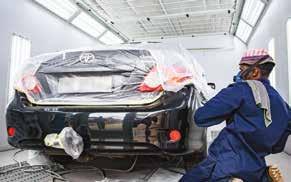

South Africa has a sophisticated legal, regulatory and banking system. Setting up a business in South Africa is a relatively straightforward process with assistance b eing offered by organisations such as the Department of Trade, Industry and Competition and provincial investment agencies like the Mpumalanga Economic Growth Agency (MEGA).
South African law regulates the establishment and conduct of businesses throughout the country. Tax, investment incentives, regulations governing imports, exports and visas are uniform throughout the country.
The particular environment varies from province to province with regard to the availability of human and natural resources, the infrastructure and support services, business opportunities and the quality of life. In this respect, MEGA can offer specific advice about the business environment in the province.
Business is regulated by the Companies Act and the Close Corporation Act, which cover accounting and reporting requirements. Under
Registration with the receiver of revenue
• As a Provisional Taxpayer
• As a VAT vendor
• For Pay As You Earn (PAYE) income tax payable on money earned by employees
• For Standard Income Tax on Employees
Registration with the Department of Labour Businesses employing staff will have to contact the Department of Labour regarding mandatory contributions to the Unemployment I nsurance Fund (UIF). Register with Compensation Commissioner for Compensation Fund Files with the Compensation Fund (in the Department of Labour) for accident insurance (Workmen’s Compensation).
Registration with the local authority
Relevant only to businesses dealing in fresh foodstuffs or health matters.
Other procedures
• Checking exchange control procedures (note that non-residents are generally not subject to exchange controls except for certain categories of investment).
30 2620 FREESTATEBUSINESS 2022 SPECIAL FEATURE 26 FREESTATEBUSINESS 2021 SPECIAL FEATURE
MPUMALANGA BUSINESS 2022/23
46 MPUMALANGA BUSINESS 2023/24
MPUMALANGA BUSINESS 2023/24
• Obtaining approval for building plans
• Applying for industry and export incentives
• Applying for import permits and verifying import duties payable
• Registering as an exporter if relevant and applying for an export permit.
Business entities
or she has tried to find a suitably qualified local employee prior to hiring a foreigner?
INDUSTRIALPROPERTYTORENTINHARRISMITH FDCisrentingout18850sqmstandalonefactoryincludingFurniture ManufacturingMachinery,Equipment,andFurnitureforBusiness Operation..
INDUSTRIALPROPERTYTORENTINHARRISMITH FDCisrentingout18850sqmstandalonefactoryincludingFurniture ManufacturingMachinery,Equipment,andFurnitureforBusiness Operation..

ThefactoryisSituatedatSite2277inHarrismithandcloseproximitytoallamenities,on mainarterialroutesandQuickaccessontoN3Freeway.
• Is the prospective employee appropriately qualified and do they have the relevant experience?
ThefactoryisSituatedatSite2277inHarrismithandcloseproximitytoallamenities,on mainarterialroutesandQuickaccessontoN3Freeway.
Thisfactoryoffersthefollowing: SprinklerSystem.
4RollerDoors
Business permits
Thisfactoryoffersthefollowing: SprinklerSystem.
4RollerDoors
There are a variety of forms which businesses can take, including private and public companies, personal liability companies, non-profit companies, state-owned companies and even branches of foreign companies (or external companies).
Security uardHouse Wellfencedandsecured Ampleparking
3phasepowerwith100amps
Security uardHouse
Wellfencedandsecured
8toilets,6officesandboardroom,reception,kitchenandseparatewarehouseablutionswith shower
Ampleparking
3phasepowerwith100amps
Occupationavailableimmediately.PleasecontactMrTefoMatlaformore informationortoview:
8toilets,6officesandboardroom,reception,kitchenandseparatewarehouseablutionswith shower
Tel 0514000800Email tefo fdc.co. awww.fdc.co. a
Foreign nationals who wish to establish their own business or a partnership in South Africa must, apart from having sufficient funds to support themselves and their family, be able to invest at least R2.5-million in the business.
Occupationavailableimmediately.PleasecontactMrTefoMatlaformore informationortoview:
Branches of foreign companies fall under Section 23 of the Companies Act of 2008 and are required to register as “external companies” with the CIPC. An external company is not required to appoint a local board of directors but must appoint a person resident in South Africa who is authorised to accept services of process and any notices served on the company. It must also appoint a registered local auditor and establish a registered office in South Africa.
Patents, trademarks and copyrights
Trademarks (including service marks) are valid for an initial period of 10 years and are renewable indefinitely for further 10-year periods. Patents are granted for 20 years, normally without an option to renew. The holder of a patent or trademark must pay an annual fee in order to preserve its validity. Patents and trademarks may be licensed but where this involves the payment of royalties to non-resident licensors, prior approval of the licensing agreement must be obtained from the dtic. South Africa is a signatory to the Berne Copyright Convention.
Permits for foreign nationals Work permits
In considering whether or not to grant a work permit, the Department of Home Affairs will first evaluate the validity of the offer of employment by conducting a number of checks to confirm the following:
• Has the Department of Labour been contacted?
• Has the position been widely advertised?
• Is the prospective employer able to prove that he
FDCISZEROTOLERANCETOFRAUDANDCORRUPTION.PLEASEREPORTFRAUDAND CORRUPTIONINCIDENTSTOTHEFRAUDHOTLINE0800212154

Tel 0514000800Email tefo fdc.co. awww.fdc.co. a
CORRUPTIONINCIDENTSTOTHEFRAUDHOTLINE0800212154
The funds must originate overseas, be transferable to South Africa and belong to the applicant (ie emanate from the applicant’s own b ank account). The business must also create jobs for South African citizens. After six months to a year, proof will have to be submitted that the business is employing South African citizens or permanent residents, excluding family members of the employer.
Appl ications for work permits for selfemployment can only be lodged at the South African Consulate or Embassy in the applicant’s country of origin. The processing fee is US$186. The applicant would also have to lodge a repatriation guarantee with the consulate/embassy equivalent to the price of a one-way flight from South Africa back to his or her country of origin.
This guarantee is refundable once the applicant has either left South Africa permanently or obtained permanent residence. Any application for an extension of a business permit may be lodged locally. The processing fee per passport holder is R425. Some countries also need to pay R108 per return visa.
A list of countries to which this applies is available from the Department of Home Affairs. MEGA assists in vestors in applying for the relevant work permits to conduct their business.
A list of countries to which this applies is available from the Department of Home Affairs. MEGA assists investors in applying for the relevant work permits to conduct their business.
A list of countries to which this applies is available from the Department of Home Affairs. MEGA assists investors in applying for the relevant work permits to conduct their business.
What can MEGA do for you?
MEGA will help new businesses by assisting in project appraisal and packaging, putting investors in touch with relevant agencies and government departments, a lerting i nvestors to i nvestment incentives and setting up joint ventures where required. ■
2731 FREESTATEBUSINESS 2022 27 FREESTATEBUSINESS 2021
SPECIAL FEATURE
FDCISZEROTOLERANCETOFRAUDANDCORRUPTION.PLEASEREPORTFRAUDAND
2021/22 MPUMALANGA 2018/19 MPUMALANGA BUSINESS 2022/23 2021/22 MPUMALANGA 2018/19
47 MPUMALANGA BUSINESS 2023/24 2021/22
MPUMALANGA BUSINESS 2023/24
South African investment incentives

The South African government, particularly the Department of Trade, Industry and Competition, has a range of incentives available to investors, existing companies, entrepreneurs and co-operatives across many sectors.
South Africa wishes to diversify its economy a nd incentives are an important part of t he strategy to attract investors to the country.
The Department of Trade, Industry and Competition (the dtic) is the lead agency in the incentives programme, which aims to encourage lo cal and foreign investment into targeted economic sectors, but the Industrial Development Corporation (IDC) is the most influential funder of projects across South Africa.

Th e re are a variety of incentives available and these incentives can broadly be categorised according to the stage of project development:


• C onceptualisation of the project – including feasibility studies and research and develop-
ment (grants for R&D and feasibility studies, THRIP, Stp, etc)
• C apital expenditure – involving the creation or expansion of the productive capacity of businesses (MCEP, EIP, CIP, FIG, etc)
• Competitiveness enhancement – involving the introduction of efficiencies and whetting the competitive edge of established companies and commercial or industrial sectors (BBSDP, EMIA, CTCIP, etc)
• S ome of the incentives are sector-specific, for example the Aquaculture Development and Enhancement Programme (ADEP), Clothing and Textile Competitiveness Improvement Programme (CTCIP) and the Tourism Support Programme (TSP).
MPUMALANGA BUSINESS 2022/23 28 14 MPUMALANGABUSINESS 2021/22 10 MPUMALANGABUSINESS 2020/21 SPECIAL FEATURE
Credit: Roger Bosch/Brand SA
Tourism is a popular investment sector. Thebe Tourism Group has invested in a luxury hotel on the Skukuza bridge. The Kruger Shalati Development is in the Kruger National Park.
MPUMALANGA BUSINESS 2023/24
The Provincial Government of Mpumalanga is rolling out infrastructure at the newly-recognised World Heritage Site at the Barberton Makhonjwa Mountains, which will make it more attractive to investors. Credit: Tony Ferrar/UNESCO
Manufacturing
Key components of the incentive programme are the Manufacturing Incentive Programme (MIP) and the Manufacturing Competitiveness Enhancement Programme (MCEP). The initial MCEP, launched in 2012, was so successful that it was oversubscribed with almost 890 businesses receiving fundin g. A second phase of the programme was launched in 2016. The gran ts are not handouts as th e funding covers a maximum of 50% of the cost of the investment, with the remaind er to be sourced elsewhere.
The Enterprise Investment Programme (EIP) makes targeted grants to stimulate and promote investment, BEE and employment creation in the manufacturing an d tourism sectors. Aimed at smaller companies, the maximum grant is R30million. Specific tax deductions are permissible for larger companies investing in the manufacturing sector under Section 12i of the Income Tax Act.
Other incentives
Other incentives available to investors and existing businesses in more than one sector include the:
• Technology and Human Resources for Industry Programme (THRIP)
• Support Programme for Industrial Innovation (SPII)
• Black Business Supplier Development Programme (BBSDP), which is a cost-sharing grant offered to black-owned small enterprises
• Critical Infrastructure Programme (CIP) that covers between 10% and 30% of the total development costs of qualifying infrastructure

• C o-operative Incentive Scheme, which is a 90:10 matching cash grant for registered primary co-operatives
• S ector Specific Assistance Scheme, which is a reimbursable 80:20 cost-sharing grant that can be applied for by export councils, joint action groups and industry associations.
Incentives for SMMEs
A lot of emphasis is placed on the potential role of small, medium and micro enterprises in job creation and a number of incentives are design-
Investments in infrastructure can attract rebates. The Highveld Industrial Park hosts factories in different sectors.

Many incentives are available to support small businesses and startups. Established businesses are encouraged to support smaller entities along their supply chain. Credit: Seda
PG Bison are investing heavily in expanding manufacturing capacity. Credit: PG Bison
ed to promote the growth of these businesses. These include:
• Small Medium Enterprise Development Programme (SMEDP)
• Isivande Women’s Fund
• Seda Technology Programme (Stp).
• Seda is the Small Enterprise Development Agency, an agency of the Department of Small Business Development that exists to promote SMMEs.

Trade-related incentives
The Export Marketing and Investment Assistance (EMIA) Scheme includes support for local businesses that wish to market their businesses internationally to potential importers and investors. The scheme offers financial assistance to South Africans travelling or exhibiting abroad as well as for inbound potential buyers of South African goods. ■
Department of Trade, Industry and Competition: www.thedtic.gov.za
Industrial Development Corporation: www.idc.co.za

Mpumalanga Economic Growth Agency: www.mega.gov.za
Official South African government incentive schemes: www.investmentincentives.co.za
33 29 MPUMALANGA BUSINESS 2022/23 15 MPUMALANGABUSINESS 2021/22
11 MPUMALANGABUSINESS 2020/21
Online Resources
MPUMALANGA BUSINESS 2023/24
10 REASONS WHY YOU SHOULD INVEST IN SOUTH AFRICA

HOT EMERGING MARKET
Growing middle class, affluent consumer base, excellent returns on investment.
LARGEST PRESENCE OF MULTINATIONALS ON THE AFRICAN CONTINENT
SA is the location of choice of multinationals in Africa. Global corporates reap the benefits of doing business in SA, which has a supportive and growing ecosystem as a hub for innovation, technology and fintech.
01. 05.
FAVOURABLE ACCESS TO GLOBAL MARKETS
The African Continental Free Trade Area will boost intra-African trade and create a market of over one billion people and a combined gross domestic product (GDP) of USD2.2-trillion that will unlock industrial development. SA has several trade agreements in place as an export platform into global markets.
02. 06.
MOST DIVERSIFIED ECONOMY IN AFRICA
South Africa (SA) has the most industrialised economy in Africa. It is the region’s principal manufacturing hub and a leading services destination.
ADVANCED FINANCIAL SERVICES & BANKING SECTOR
SA has a sophisticated banking sector with a major footprint in Africa. It is the continent’s financial hub, with the JSE being Africa’s largest stock exchange by market capitalisation.
07.
YOUNG, EAGER LABOUR FORCE
SA has a number of world-class universities and colleges producing a skilled, talented and capable workforce. It boasts a diversified skills set, emerging talent, a large pool of prospective workers and government support for training and skills development.
03. 09.
04. 08.
PROGRESSIVE CONSTITUTION & INDEPENDENT JUDICIARY
SA has a progressive Constitution and an independent judiciary. The country has a mature and accessible legal system, providing certainty and respect for the rule of law. It is ranked number one in Africa for the protection of investments and minority investors.
ABUNDANT NATURAL RESOURCES
SA is endowed with an abundance of natural resources. It is the leading producer of platinum-group metals (PGMs) globally. Numerous listed mining companies operate in SA, which also has world-renowned underground mining expertise.
WORLD-CLASS INFRASTRUCTURE AND LOGISTICS
A massive governmental investment programme in infrastructure development has been under way for several years. SA has the largest air, ports and logistics networks in Africa, and is ranked number one in Africa in the World Bank’s Logistics Performance Index.
10.
EXCELLENT QUALITY OF LIFE
SA offers a favourable cost of living, with a diversified cultural, cuisine and sports offering all year round and a world-renowned hospitality sector.
SOUTH AFRICAN BUSINESS 2020 19
Page | 2 WWW.GLOBALAFRICANETWORK.COM | WWW.NORTHERNCAPEBUSINESS.CO.ZA JOIN US ONLINE WWW.GLOBALAFRICANETWORK.COM | WWW.NORTHERNCAPEBUSINESS.CO.ZA US ONLINE WWW.GLOBALAFRICANETWORK.COM | WWW.NORTHERNCAPEBUSINESS.CO.ZA ONLINE

Agriculture 38 Forestry and paper 39 Mining 42 Oil and gas 48 Manufacturing 50 Transport and logistics 54 Tourism 56 ICT 58 Education and training 60 Banking and financial services 62 Development finance and SMME support 64 Overviews of the main economic sectors of Mpumalanga
KEY SECTORS
Sappi’s Ngodwana Mill plays a big role in Mpumalanga’s economy. A key part of the manufacturing sector for many years, it is also the site of a 25MW biomass energy project. The company contributes about R5-billion to the regional economy. Credit: Sappi

OVERVIEW
Agriculture
SECTOR INSIGHT
nations. In addition, South Africa’s farmers import about 80% of fertiliser, much of it from Ukraine.

The South African macadamia industry expects to produce 83 556 tons in 2023, a better crop estimate than 2022 and much better than the 53 000 tons achieved in 2021. Fully 97% of the crop is exported.
Thousands of new trees are being planted every year. In 2022, Mpumalanga was responsible for 37% of the country’s 6 235 new hectares. There are more than 65 000 hectares planted to macadamias in the country. Sophisticated machinery (pictured) is increasingly being used, and data usage is becoming vital for sustainability.
Avocados are not as widespread, but the planting of 800 new hectares annually suggests that global markets are responding well to farms in Mpumalanga and elsewhere. The website of the South African Avocado Growers Association lists 25 companies that export the fruit. Mpumalanga accounts for about 21% of South Africa’s citrus production and a third of its export volumes, with Valencias being the province’s most popular varietal and Nelspruit being the centre of the sector.
Litchis, mangoes and bananas also thrive in the province. Hazyview is an important source of bananas, with 20% of South Africa’s production originating there.
The South African Subtropical Growers’ Association is an association of associations that manages the affairs of the following growers associations: South African Avocado (SAAGA), Litchi (SALGA) and Mango (SAMGA). South African agricultural exporters took a hit from the war that Russia began with Ukraine. In a normal year, the country exports five-million cartons of prunes and pears to Russia and more than double number of citrus cartons to the two combatant
ONLINE RESOURCES
Citrus Growers Association: www.cga.co.za
Macadamias South Africa: www.samac.org.za
South African Subtropical Growers’ Association: www.subtrop.co.za
An agro-processing facility is planned for the area near the Kruger Mpumalanga International Airport (KMIA) and private investors are being approached.
The Fortune 40 programme is focussed on developing young entrepreneurs in farming. Twelve of the Fortune 40 farms have been linked to retailers such as Spar, Shoprite and Boxer and with wholesalers and agro-hubs.
The goal is to have an agrohub in each of the province’s three districts. Small-scale farmers and co-operatives can connect to the formal economy via the hubs which will also provide advice and equipment. The Mkhuhlu agro-hub in Bushbuckridge, which forms part of the Provincial Government Nutrition Programme, is operational. A feasibility study is underway relating to the establishment of a hub in the Nkomazi Municipality.
Phezukomkhono Mlimi is a provincial government assistance programme providing mechanisation and input support to small-scale and new farmers. Training courses are offered by the AgriSETA. Agriculture is responsible for about 3.4% of Mpumalanga’s Gross Domestic Product (GDP). ■
38 MPUMALANGA BUSINESS 2023/24
The macadamia industry is growing fast.
800 new hectares of avocados are planted annually.
Credit: SAMAC
Forestry and paper
An agroforestry project plans to convert unused land.
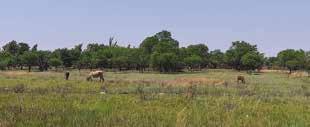
SECTOR INSIGHT
Dry bamboo biomass is one of the products that private company Terragrn wants to produce in large quantities as part of its ambitious plans to restore and use large tracts of land in Mpumalanga (pictured). The company’s stated goal is to turn up to 200 000ha of unused land into a $2-billion sustainable land-management agroforestry project over the next 10 years.
A 68ha pilot project is to be rolled on the land of the Manala Mgibe in association with the Community Property Association (CPA). Trying to create a “nature-based solution” to the worldwide problem of carbon emissions and the transition from fossil fuels, the project is targeting the agriculture and forestry sectors as a means of promoting employment and involving rural communities.
Mpumalanga has the ideal climate and topography for forests. Sabie and Graskop represent the hub of the industry, but commercial forests are also found to the east and south along the Swaziland border. About 11% of the land mass is forested, with 4% of that being natural forest. The province is the national leader in total hectares under forest (514 000ha) and in export earnings. Forestry accounts for about 8% of Mpumalanga’s gross domestic product. The sector comprises logging, saw-milling, wood product and pulp and paper manufacture. Pulp and paper are the main exports, along with sawn lumber, wood chips and wattle extract. Most sawn timber in South Africa is used in the construction sector.
One of the biggest operations in the forestry and paper sector in Mpumalanga is Sappi’s Ngodwana Mill. Although it has a big international footprint, Sappi’s biggest sales volumes are achieved in South Africa, making up nearly 50% of group sales. In
ONLINE RESOURCES
Forestry South Africa: www.forestry.co.za
Sawmilling South Africa: www.timber.co.za
Technical Association of the Pulp and Paper Industry of South Africa: www.tappi.org
the six months to March 2023, South Africa also accounted for 39.5% of operating profit. The JSE-listed company has a valuation of R22.9-billion. Sappi’s other large facility in the province, the Lomati Sawmill in Barberton, produces kiln-dried Southern African pine lumber from sawlogs supplied by Sappi Forests.
Forestry companies are looking into energy generation, including Sappi and AFCOL. Mpumalanga has 40% of South Africa’s forestry resources, which presents an opportunity to exploit the sector’s byproducts in the biomass-to-energy field.
The Industrial Development Corporation (IDC) has a stake in Hans Merensky Holdings and York Timbers, which has planted out 40ha in high-value crops as the first phase of a diversification strategy.
PG Bison, a subsidiary of KAP Industrial Holdings, is investing R560-million in a new front-end dryer for its particleboard plant in Mkhondo (Piet Retief). The company is also building a new medium-density fibreboard (MDF) plant at its Mpumalanga plant, to complement its existing factory at Boksburg in Gauteng. ■
39 MPUMALANGA BUSINESS 2023/24
Energy generation is being investigated.
OVERVIEW
Credit: Terragrn
Sappi paves the way for a sustainable future in Mpumalanga
Unlocking the power of trees.
The Mpumalanga province owes much of its vitality to the investment from local industry. For decades, the global renewable resource company, Sappi, has been a driving force contributing to the lifeblood that sustains the local economy and communities while boosting the province’s growth.
With its commercial plantations and manufacturing facilities, Sappi’s operations are instrumental in driving prosperity within the province. It contributes ZAR5.5-billion to the local economy annually and provides livelihoods for thousands of people.
While fortifying the present, Sappi also has its sights set on a brighter tomorrow. Embracing the concept of a biobased circular economy, it champions responsible forestry practices and extracts sustainable alternatives from woodfibre to reduce the reliance on fossil-based materials. Through innovative approaches, Sappi unlocks the power of trees, cultivating purpose and value from every by-product and resource it employs.
A positive foothold
At the heart of its operations in Mpumalanga lies Ngodwana Mill, a key player in the province’s economic landscape. This manufacturing entity produces unbleached chemical pulp, mechanical pulp kraft linerboard and dissolving pulp to meet domestic and international demand. In Barberton,
Lomati Sawmill provides structural lumber for, among others, the building, furniture and packaging industries.
Sappi also manages vast forestry plantations in the province, of which approximately one-third is unplanted and conserved for biodiversity. This includes the management of four conservation sites – the Ngodwana River Valley, Mount Morgan, Oosterbeek and Angle Ridge Nature Reserves.

Sappi’s various international certifications ensure that its performance is monitored and that operations comply with global best practice across a range of environmental, safety and quality criteria. These external assessments and independent third-party certifications give stakeholders confidence that reported performance indicators are reliable, accurate and pertinent.
Empowering local communities
The company’s impact also reaches well beyond economic and environmental interests.
Honouring its commitment to a better, sustainable future, Sappi holds a share in a 25MW biomass energy project set to alleviate the demand on the national grid. This endeavour goes beyond corporate interests and actively involves one of Sappi’s host communities, who have been granted a stake in the project. By including local community members as partners, Sappi is fostering a sense of ownership and shared prosperity.
Another example of community empowerment is the Ngodwana Skills Centre and Learning Hub which provides skills training and trade testing programmes
40 MPUMALANGA BUSINESS 2023/24
for apprentices, post-apprentices and engineersin-training. Moreover, community members have access to courses in basic life and hand skills, as well as specific trades like painting, electrical work, plumbing, bricklaying and cement work.
By equipping local people with practical skills, Sappi is enhancing employability and fostering entrepreneurship. The company is also actively involved in about 37 enterprise supplier development programmes, employing over 300 people – all of which nurture a resilient local economy.
Community engagement is another cornerstone of the company’s presence in the province. The Sappi Abashintshi programme uses a social mobilisation and asset-based community development (ABCD) approach to uplift and empower the youth. Deployed across several communities throughout the region, the programme stands as a shining example of bringing about positive change at grassroots level.
Over the years, the programme has resulted in hundreds of small businesses that have either been started up or rejuvenated – ranging from brickmaking projects, poultry and pig farms to crèches and home industries, while also providing welcome respite for the youth during its annual sponsored holiday programme.
Promoting education, health and wellbeing Education counts among the key social impact
priorities. Expanding the talent pool in critical areas, Sappi is nurturing the future leaders and innovators of Mpumalanga.
The importance of Early Childhood Development (ECD) is recognised as a foundation for building capacity, and in Mpumalanga, Sappi has developed an ECD Centre of Excellence at the Sappi Elandshoek community in partnership with Penreach. ECD practitioners are being taught to implement programmes at each of their sites to promote the child’s holistic development. Currently, 130 centres and about 1 000 children benefit from this programme in Mpumalanga, with many thousands more having benefited over the years.
Sappi furthermore has a vested interest in the health and wellbeing of its surrounding communities. Employees are also encouraged to get active in their communities. One example was the establishment of the Sisonke Food Security project at Lomati Mill (pictured), an initiative that gives back to employees, builds trust and supports the broader community by transforming a barren piece of land into a fertile vegetable patch to ensure food security within and around the mill, all year round.


With its wide-ranging investments in manufacturing, the environment, skills training and community upliftment, this company is a prime example of how industry can drive positive change in a province and in the lives of its people.
As a responsible corporate citizen, Sappi sets an inspiring example for others to follow, and its contributions continue to make a lasting impact and difference in this region. ■
41
FOCUS
The Sisonke Food Project: Zeus and Mphume point to success in bringing food security to the community.
MPUMALANGA BUSINESS 2023/24
One-third of Sappi’s huge forestry plantations in Mpumalanga are unplanted and conserved for biodiversity. Lothair is in the south-east of the province, in an area of wetland lakes which is famous for its birdlife.
Mining
Energy and efficiency are key for the province’s miners.
largest coal exporting region in the world. Although renewable energy is catching on in South Africa, there is no prospect of Mpumalanga’s coal-fired power stations being mothballed soon.
Gold miner Pan African Resources has secured financing for the development of its new assets in Gauteng province and remains on course to ramp up mining at the Fairview and Royal Sheba operations, which form part of the Barberton complex.
The acquisition of the liquidated Mintails operations in 2022 will increase Pan African’s production by about 50 000oz once steady production is reached at the end of 2024. The company currently has production capacity in excess of 200 000oz of gold per annum. R400-million of a R2.5-billion funding arrangement was released by Rand Merchant Bank in March 2023.
Loadshedding in 2023 slowed the process of getting the Barberton operations running at optimum levels. The company reported in May that it had lost 10 000oz worth of production because of power cuts. Tests are proving that the decision to extend deep mining at Barberton was correct. Pan African reports “potential high-grade extensions to the orebodies at Fairview, Royal Sheba and Consort mines”.
Mining contributes 25.9% of the province’s gross domestic product and employs more than 53 000 people. Mpumalanga accounts for 83% of South Africa’s coal production and is the third-

The CEO of the World Coal Association, Michelle Manook, told the 2022 Mining Indaba that coal still has an important role to play in the world’s mineral mix. Despite the country’s plan to reduce coal’s contribution to electricity generation to 43% in 2030 (from the current percentage around 70%), Manook argued that a just transition would pay greater attention to the number of jobs that the coal industry supplies. She said that coal-fired power plants employ 130 000 people and implied that the renewable sector would not easily replace those.
South Africa still has many billions of tons of coal in the ground. Council for Geoscience CEO Mosa Mabuza reports that research is ongoing into finding ways to capture carbon produced at coal-burning power stations.
A major problem facing South Africa’s mining, according to Minerals Council South Africa, is the inability of state utility Transnet to transport bulk minerals to the country’s ports in sufficient quantities to meet demand. If the Richards Bay Coal
42
Impact Catalyst Mpumalanga has been launched. OVERVIEW
SECTOR INSIGHT
MPUMALANGA BUSINESS 2023/24
Gold mining in Barberton. Credit: Pan African Resources
Terminal had operated at full capacity in 2021, an additional R47billion would have been generated in exports.
Afrimat, previously listed on the JSE in the “Construction and Building Materials” section, has changed its classification to “General Mining”, a recognition of the company’s ambitious buying programme in the Northern Cape and Mpumalanga. With construction and building now contributing just 20% to operating profit, Afrimat is active in anthracite and iron ore and will further expand into phosphates, rare earth elements and vermiculite.
Among its new acquisitions, Afrimat now controls the Nkomati Anthracite mine in Mpumalanga. The mine, which is in the southeastern corner of the province, has proven resources of 8.7-million tons and upwards of 400 jobs were created over the last two years. Local communities have a 16.1% stake in the relaunched mine and the Mpumalanga Economic Growth Agency (MEGA) holds 34%.
Platinum
Platinum is an important mineral for the modern economy. Two Rivers is a joint venture between Implats (46%) and African Rainbow Minerals which is located on the southern part of the eastern limb of the Bushveld Igneous Complex, 35km south-west of Burgersfort in Mpumalanga. Northam Platinum, which has assets on both limbs of the Bushveld Igneous Complex, has purchased the Everest mine from Aquarius Platinum. Everest is adjacent to Northam’s existing Booysendal mine.
Jubilee Platinum has sold its Smelting and Refining business in Middelburg to Siyanda Resources. Sylvania Platinum now has seven PGM recovery plants that extract chrome from tailings on both sides of the Bushveld Igneous Complex.
Lydenburg is home to the Lion ferrochrome smelter that is a joint venture between Glencore and Merafe Resources. Assmang, the joint venture between ARM Ferrous and the JSE-listed Assore, operates a chrome mine (Dwarsrivier) and a ferrochrome plant where chrome alloys are made.
Energy and transition plans
Another part of Pan African Resources’ plan to improve efficiencies was to build a renewable energy plant at Elikhulu. A 10MW solar plant, which produces 30% of the facility’s needs, started operating in 2021.
ONLINE RESOURCES
Council for Geoscience: www.geoscience.org.za
Minerals Council South Africa: www.mineralscouncil.org.za
National Department of Mineral Resources and Energy: www.dmre.gov.za
South African Institute of Mining and Metallurgy: www.saimm.co.za
By mid-2022, the company reported a monthly saving of $145 000 per month. Exxaro, one of the biggest mining companies in Mpumalanga, has a subsidiary, Cennergi, that builds and manages renewable energy plants. Two wind farms have been built in the Eastern Cape and the plan is now to build plants near Exxaro mining sites.
The ambitious renewable energy plans of Seriti Green, subsidiary of coal-miner Seriti Resources, are outlined in a Special Feature elsewhere in this journal.
Impact Catalyst Mpumalanga has been launched in Mpumalanga, having previously operated in two of South Africa’s other big mining provinces, Limpopo and the Northern Cape. Impact Catalyst aims to drive large-scale socioeconomic development initiatives through publicprivate partnerships and a big focus in Mpumalanga is going to be the transition to green energy. An initiative of Anglo American and Exxaro, the Council for Scientific and Industrial Research (CSIR) and World Vision, Impact Catalyst will assist with mine and power station closures, ensuring that they are done in a way that protects the environment and, where possible, setting up manufacturing or agricultural opportunities for local communities. ■
43
MPUMALANGA BUSINESS 2023/24 OVERVIEW
Mapping for safety and economic growth
Dr Taufeeq Dhansay, Manager of the Minerals and Energy Geoscience Mapping Programme, explains how important geoscientific mapping can be for every aspect of society and gives a progress report on the Council for Geoscience’s carbon capture research.

In recent mapping, what have you found in Mpumalanga?
Mpumalanga is very rich is terms of its geological variety. You find some of the earth’s oldest rocks that tell you about how the earth evolved and formed. Many international scientists visit the province to investigate these rocks, some that are more than four-billion years old. You also find some of the youngest rocks, so that variety from the oldest to youngest means that you have the entire history of the earth’s processes within the province. Some of these processes include how various minerals systems formed and evolved.
This implies that it is a very rich province in terms of its natural resources. This includes, coal, gold, platinum and other types of critical minerals that are needed to sustain future energy like renewable resources and batteries.
Now we are looking at integrated research. What happens as we shift away from coal in the province? Does it mean that the coal was the only drawcard of the province in terms of its economy? We are finding that the answer is no.
Is coal the province’s only resource?
BIOGRAPHY
After earning a bachelor’s degree in Geosciences from the University of Cape Town, Taufeeq spent time at the International Institute for Applied Systems Analysis in Austria on his way to a Master’s, where his focus was geothermal energy. Another overseas experience was at the Structural Geology and Tectonics Research Group at Jena University in Germany. Nelson Mandela University awarded Taufeeq a PhD in Geosciences in 2017.
There are other mineral resources that can also be looked at. That is a primary focus at the moment. More than two thirds of the province’s economy is now reliant on coal so this brings into context the idea of the just transition.
We are asking what geoscience can tell us about a transition in terms of sustainability.
Coexistence between mining and agriculture only happens if you understand the geology. We have to maintain the integrity of the groundwater in such a way that you can have mining and agriculture existing perfectly in harmony. We are finding that this is possible. Secondly, if you can identify an area where you might find a fossil fuel on the surface like coal, then you can dig a bit deeper and find gas. Deeper still and you might find gold. That means that in terms of the valuation and the investment potential, the land is looked at differently, both for the GDP and for the sustainability of life in the province.
44 MPUMALANGA BUSINESS 2023/24
INTERVIEW
Dr Taufeeq Dhansay, Manager, Council for Geoscience
If you draw a cross-section through Mpumalanga, within the top four kilometres we have found a number of mineral resources and natural resources such as groundwater. Secondly, this is a good natural laboratory where you can study and look into the issue of sustainability.
Mpumalanga is also the site of your Carbon Capture Utilisation Storage (CCUS) project. How is that progressing?

Mpumalanga has the highest CO2 emissions in the country, which is no surprise because this is where we have the bulk of the coal-fired energy plants.
We were challenged as scientists to look at the issue. We have to transition towards a low-carbon economy. This is known. If tomorrow you had to turn off coal what would happen to the 150 000 people directly employed by the coal industry? The challenge is how to manage this transition in a way that actually enables sustainability. This is where the just transition comes in.
The problem is CO2, carbon dioxide. Technologies exist where you can capture the carbon dioxide. You do not release the carbon dioxide into the atmosphere. Carbon dioxide has many uses. There are a number of things that you can do with the carbon dioxide. Many industrial processes require carbon dioxide: we drink sparkling water, we drink fizzy cooldrinks. Those products use carbon dioxide, for example.
We had assumed that South Africa’s larger storage potential for carbon dioxide was generally near-shore, so we were looking at coastal provinces and offshore. That’s because the relevant rocks are very spongy, or absorbent of CO2. Now we have gone back to Mpumalanga and we have looked underground to find if there are additional geological areas where you can viably and safely store the CO2. This is what we have found. We have recently published a paper that shows these rocks could very likely support the injection and sequestration of CO2.
Would the gas disappear or would it stay there forever?
The idea would be that we take the gas and convert it into a solid. When CO2 reacts with certain metals, it forms a new mineral that just has the carbon incorporated. By the way, this actually happens in nature. We stop the gas from going into the atmosphere, and put it in the ground. It reacts naturally with other types of minerals which are very reactive and then it forms a new mineral and it stays in the ground forever. That is the principle.
How far advanced are you along that road?
The first step is that we have identified the potential reservoirs. Everything comes down to

45 MPUMALANGA BUSINESS 2023/24
The geological profile beneath Leandra, Mpumalanga.
Council for Geoscience scientists logging borehole core from Mpumalanga.
making this financially viable so it is important to mention that these areas are below the current coal fields. You would not need to transport the CO2 very far to be stored.
The type of storage is quite critical. At a depth of about 1km you find saline aquifers. That holds the type of water that you can’t necessarily use for anything. If you pump the CO2 into that salty water, the CO2 slowly reacts with the salt in the water but it can take up to thousands of years before the CO2 becomes immobile. However, if you store the CO2 in the type of rocks that we are looking at, that reaction can theoretically happen much quicker. The sooner you convert the gaseous CO2 into a solid CO2, the sooner it is rendered immobile. Then it cannot move around and get back into the atmosphere.
What effect would these processes have on the environment?
A lot of our work so far has been specifically on environmental monitoring. This is a critical point. Before we actually develop this technology, we are doing a significant amount of environmental research to make sure that we can understand the baseline environmental conditions on the ground.

We want to get a footprint of the area – the flora, the fauna, the chemistry of the groundwater, the amount of groundwater there is – all of that information.
Are CGS staff excited about the CCUS project?
Yes. It is a very big project. The principle is that it’s a challenge. There are a lot of different opinions around the transition. Some say we are not moving fast enough. Others say we are moving too fast. This is the nice thing about being pragmatic – a fundamental scientist if you like – being practical and finding solutions that will be sustainable.
Our technology for renewables is still developing; we are not there entirely yet. It’s a big challenge and we need to buy ourselves some time. For the first time in a long time, the issue is being looked at directly by scientists, not necessarily only by policymakers. We have to guide them, we need to show what is possible, scientifically and empirically. How do you present empirical data that has passed peer review? That is the principle that we are focusing on.
The carbon capture project is a large, integrated project. The project is funded both by the South African Government and the World Bank and the entire project budget is about $23-million.
46 MPUMALANGA BUSINESS 2023/24 INTERVIEW
The hyperspectral core scanner in use at the Council for Geoscience National Core Library.
We have to be very unbiased in terms of the type of research we do. We will be doing full Environmental and Social Impact Assessments (ESIAs) before we do any type of sub-surface investigation. Our data portal is available to the public online.
At the CGS you will find somebody who is working on hydrogeology, while another person is an environmental geologist, who might be interested in what this is going to do for the environment.
What is the nature of new mapping CGS is doing?
The first thing to touch on is that what we are doing is very much geoscientific mapping, not just geological. The second thing is that the scale is very important. We have generally mapped to a scale of 1:250 000, so that means if a hill is less than 250 metres, it will not appear on the geological map. We have shifted to the 1:50 000 scale. South Africa was only covered to 4% in terms of 1:50 000-scale maps. After about five years, we are now moving up to a figure of 12%.
People often think that mapping is for minerals only. What other functions does it have?
We have not exclusively focused on minerals. We’ve been able to identify certain zones and certain geological features where specific types of geohazards are concentrated. We are researching that further to mitigate possible natural disasters or loss of human life.
The recent landslides in KwaZulu-Natal are an example. Many of the landslides are due to specific geomorphology and geological controls. If we don’t have the map resolution required, we can’t necessarily create the necessary mitigation scenarios. The same is true in Gauteng. A large portion of Gauteng is built on dolomite, the type of rock that forms sinkholes. The state spends a lot of money on infrastructural development and the risks can be mitigated if we understand the geology.
There are many areas in the country where the dams are not efficient in supporting farming, so we look at groundwater resources. To understand those resources, you need to understand the geology of very specific structures, essentially pathways that allow the water to flow. The other aspect that is not necessarily being considered is the surface of the earth. This is where all of our food comes from. In areas where we want agricultural sustainability,
you need to understand the geology of those areas. Similarly, you cannot build a large solar plant on soil that might sustain agriculture. We want to avoid sterilising the ground and ruling out the possibilities of groundwater or minerals.
Tell us more about groundwater.
We have been very successful in identifying significant groundwater resources, especially in the Karoo. We have been able to find, test and research many groundwater aquifers that can sustain groundwater resources in those areas.
And what are the new maps showing in terms of mineral resources?
We have focused on specific areas where we anticipate there to be some investment in exploration. Some of the mineral resources we are also looking at in terms of our developmental needs. We have to look for the type of minerals needed to sustain renewable energy, including batteries.
A number of mineral resources can support battery development. Specifically, mobile devices have lithium ion batteries and some of our mapping has discovered that South Africa has quite a significant quantity of lithium that can possibly be extracted and researched.
Where is lithium found?
It is mostly in the Northern Cape and it is also found in KwaZulu-Natal. We also found lots of vanadium, which is a critical metal needed for larger-format batteries. So mapping goes far beyond mining, it’s vital to every aspect of the economy.
Development hinges on earth science. We need to understand the earth. When we map, we try as hard as possible to look as deep as possible. Humans generally interact with the top five kilometres of the earth. We have gold mines that touch four kilometres. If you go to any province the geology you see just below your feet is not necessarily the geology that you will see at a kilometre below your feet. The Karoo might be dry but if you had to go down several hundred meters you would find significant natural resources to sustain socioeconomic development, such as water and minerals. ■
47 MPUMALANGA BUSINESS 2023/24 INTERVIEW
Oil and gas
Sasol partnerships point to a new path.
company from the Department of Chemistry of the University of Oxford. The project aims to invest in about 500MW of renewable energy that will supply a 200MW electrolyser for green hydrogen production, resulting in approximately 45 000 tons a year of sustainable aviation fuel (SAF).
In 2021, agreements were signed with Toyota and the Industrial Development Corporation (IDC) relating to green hydrogen and Sasol joined the Hydrogen Council.
International chemicals and energy company Sasol has several large plants in Mpumalanga and it has been the dominant national player in these sectors for decades.
With more than 30 000 employees and a presence in 30 countries, the decisions Sasol make have a big impact on society. A series of partnerships entered into by Sasol illustrate that the company has decided that the energy future has to be different to the present.
Subsidiary company Sasol ecoFT is producing sustainable fuels and chemicals from green hydrogen and sustainable carbon sources via the Power-to-Liquids process and using the FischerTropsch technology (FT) which has helped set the company apart in its field.
In 2010 Sasol flew the world’s first passenger aircraft using fully-synthetic jet fuel and it has been investigating solutions ever since. Sasol is part of a consortium based at its Secunda operations called HyShiFT with Linde, Enertrag and HydRegen, a spinoff
With the IDC, Sasol aims to develop a green hydrogen market in South Africa, develop policy guidelines, support pilot projects and investigate funding options for the nascent sector. One such pilot project is to develop the N3 highway, South Africa’s busiest road, into a green corridor for long-haul trucks powered by hydrogen. Toyota is building the trucks in Japan for use on the route.
In 2022 the Green Fuels Hamburg consortium and Sasol ecoFT agreed to work together and the company signed a Memorandum of Understanding (MoU) with German aircraft manufacturer Deutsche Aircraft to work on technology for sustainable aviation fuel using green hydrogen.

48
PASA has issued natural gas exploration permits.
OVERVIEW MPUMALANGA BUSINESS 2023/24
SECTOR INSIGHT
Aviation is responsible for 3% of global carbon emissions. Solutions are being worked on in Mpumalanga. Credit: Lawrence Hookham on Unsplash
In 2023 Sasol ecoFT and Topsoe signed an MoU to establish a 50/50 Joint Venture (JV) to develop SAFs. The JV will develop, build, own and operate ventures producing SAF based on Sasol’s FT technology and Topsoe’s SAF technologies. The two companies have been technology partners for more than two decades.
Gas future
Products manufactured at the Sasol complex in Secunda include synthetic fuel, petroleum, paraffin, jet fuel, creosote, bitumen, diesel and lubricants. The primary feedstock for synthetic-fuel production is coal, and the plant is in the heart of Mpumalanga’s coalfields.
Sasol Gas is one of the four operations at Secunda, supplying natural gas to Sasol Synfuels and buying Sasol Synfuels’ methanerich pipeline gas to sell to customers in Mpumalanga and KwaZuluNatal. The octene plant makes octene, a hydrocarbon molecule which is used in agrochemicals, plasticisers and synthetic lubricants.
Sasol announced in 2021 the sale of its 30% stake in the Romco natural gas pipeline that links Mozambique and South Africa. As part of a global sell-off of assets to reduce debt, Sasol expects to earn more than R5-billion from the transaction. The company will continue to be the pipeline’s operator and maintains a 20% stake in the venture.
The Romco pipeline could carry far more gas in the future as there have been big finds of new gas off the coast of Mozambique which could be shipped as liquefied natural gas (LNG) to Maputo and continue from there to the Sasol plant at Secunda. The province is already equipped with energy and fuel infrastructure and expertise.
The Liquefied Natural Gas Independent Power Producer Procurement Programme (LNG IPPPP) is part of the broader programme of the National Department of Mineral Resources and Energy which encourages private investment in renewable energy, namely the Renewable Energy Independent Power Producer Procurement Programme (REIPPPP). The total allocated to gas-topower in the national power plan is 3 726MW, of which 3 000MW is for LNG.
The REIPPPP has seen investment into this totally new sector of more than R200-billion since 2012 and South Africa is now home to 112 independent power projects, whereas just 13 years ago there were fewer than 40 in Sub-Saharan Africa.
ONLINE RESOURCES
HyShiFT: www.hyshift.org
Independent Power Producer Programme: www.ipp-projects.co.za
Petroleum Agency South Africa: www.petroleumagencysa.com
PetroSA: www.petrosa.co.za
Three natural gas exploration permits have been awarded to Tosaco Energy for the sandstonerich area between Amersfoort and Balfour in the western part of the province by Petroleum Agency South Africa (PASA). PASA regulates exploration and production activities and acts as the custodian of the national petroleum exploration and production database. Tosaco Holdings has a 25% stake in Total SA. Two methane-gas exploration rights have been granted to Highland Exploration in the Evander area.
The promoters of the Nkomazi Special Economic Zone believe that the fact that the pipeline passes through the SEZ is a big selling point. An alternative would be for the LNG to be shipped to Richards Bay before being piped north.
Many of the big mining and manufacturing concerns in Mpumalanga have long-term contracts for the supply of gas with big gas companies. Afrox and Air Liquide are two of the biggest, with the latter having 3 500 national customers, including Sappi and Sasol.
Air Liquide is to start operating 16 air separation units (ASUs) as a result of an R8-billion purchase from Sasol. The company’s fleet now comprises 17 ASUs in Secunda, with the 16 units having the capacity to produce 42 000 tons per day of oxygen. ■
MPUMALANGA BUSINESS 2023/24 49 OVERVIEW
Manufacturing
New sectors are arising from the green economy.
and chemical production occurs in the southern Highveld region clustered around Sasol’s plants. The Sasol chemicals and liquid fluids complex at Secunda is a vital component of Mpumalanga’s manufacturing sector. Also in the southern section is the town of Standerton which hosts several large manufacturing plants. Chief among these are a chickenprocessing facility and two mills, one for textiles and the other for crushing soy.
The assembly of solar-voltaic panels, building bases and towers for wind turbines and making equipment required for batteries – these are all areas where there might be potential for new manufacturing jobs as Mpumalanga’s economy starts to transition to renewable energy.
Containerised mini-grids are being already being assembled in the workshops of the Komati Power Station, which was decommissioned in 2022. Because the site is serviced by the transmission grid, it will also be converted into a generation site for 150MW of solar, 70MW of wind and 150MW of storage batteries, which will create the potential for other manufacturing enterprises to locate there. Camden Power Station (pictured), near the town of Ermelo and also scheduled for decommissioning, could be the site of similar activities.
The Mpumalanga Provincial Government is working with the Presidential Climate Commission, the Climate Investment Fund and the World Bank to find ways to diversify the local economy. A key objective of the Mpumalanga Economic Growth and Development Path (MEGDP) is to expand the industrial base of the provincial economy. From steel to chemicals, petroleum and stainless steel to paper and fruit juice, Mpumalanga makes a wide variety of products. Fuel, petroleum

Astral Foods’ Goldi processing plant has its own breeding and hatching operation and a processing capacity of approximately 1.8-million broilers per week. The company has won a court order to compel the local municipality to supply services after Astral’s production levels were disrupted by intermittent water and electricity supply. Goldi is the largest employer in Standerton.
Standerton Mills designs, manufactures and finishes yarn and woven industrial fabrics. The company, which was established in 1947, integrates aspects of manufacturing across a variety of technical fabrics and yarn, offering a stand-alone or fully integrated end-to-end service which includes designing, spinning, twisting, weaving and coating.
Mpumalanga is home to multiple steel and timber mills.
OVERVIEW
SECTOR INSIGHT
MPUMALANGA BUSINESS 2023/24 50
COFCO International’s Standerton Mill is the country’s biggest soy-crushing facility. Credit: COFCO
COFCO International’s soy-crushing plant in Standerton has 120 employees and is the biggest facility of its kind in South Africa. The company has more than 11 000 employees worldwide and is active on all continents. Feedstock for the plant comes from partner farms and third parties to produce oil and soy meal for animal feed. Work on efficiency and other improvements at the plant has led to a doubling in volumes processed.
Standerton falls within the Maize Triangle that touches four provinces. Within that area COFCO operates a 30 000-hectare contract farming operation which provides soybeans to the Standerton facility and maize for domestic consumption.
The northern Highveld area, including Middelburg and eMalahleni (Witbank), is home to ferro-alloy, steel and stainlesssteel concerns.
In the Lowveld, agricultural and forestry products are processed while Sappi’s giant mill is close to the company’s forests south-west of the provincial capital, Mbombela. Timber firm and board manufacturer PG Bison is in the process of spending more than R2-billion on increasing capacity at its Mkhondo plant.
TSB Sugar runs two large mills and produces fruit juices through a subsidiary company. Nelspruit is the centre of the province’s foodprocessing cluster. Approximately 70% of jobs in the manufacturing sector are in food and forestry.
Steelmaking is a key strategic industry for South Africa, representing 1.5% of the country’s GDP and accounting for about 190 000 jobs. According to the South African Iron and Steel Institute (SAISI), the South African steel industry value chain multiplies the value of local iron ore by a factor of four. Middelburg-based Columbus Stainless is South Africa’s only producer of stainless-steel products.
The dtic’s Agro Processing Support Scheme (APSS) includes furniture manufacture as a core sector for future growth and
ONLINE RESOURCES
Highveld Industrial Park: www.highveldindustrialpark.co.za
Mpumalanga Economic Growth Agency: www.mega.gov.za
South African Furniture Initiative: www.furnituresa.org.za
South African Iron and Steel Institute: www.saisi.co.za
support. Average employment per manufacturer is 13 people per facility. Furntech White River is a part of the Seda Technology Programme of the Small Enterprise Development Agency (Seda).
The Furniture Sector Forum has become an annual event, the fourth of which was held in 2022. At the event, government incentives and ideas about how to reduce the cost of expensive machinery through co-ownership and partnerships are shared, together with other strategic ideas. The first forum was co-hosted by the South African Furniture Initiative (SAFI), Proudly South African, PG Bison and the Department of Trade, Industry and Competition (dtic). A national Furniture Industry Master Plan (FIMP) was adopted in 2021, which subsequently led to the reorganising of SAFI into seven chambers.
Enaex Africa, the new joint venture comprising Enaex and what used to be Sasol Explosives, will spend R16million on a facility to assemble detonators in Secunda. The facility is intended to produce 800 000 detonators per annum. Enaex, a subsidiary of the Sigdo Koppers Group, is the controlling partner in the JV. ■
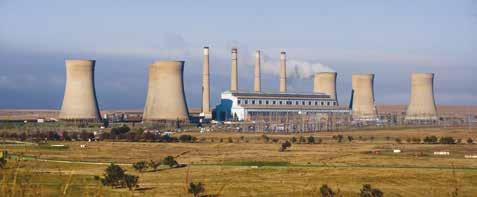
MPUMALANGA BUSINESS 2023/24 51
Columbus Stainless
Choosing the right metal for the future.
advantage is that stainless steel is also considered an environmentally-sustainable material of choice, since it is 100% recyclable and is produced using predominantly recycled materials. The future of manufacturing is indeed Stainless.
Columbus Stainless, based in Middleburg, Mpumalanga, is a subsidiary of the Spanish group of companies, Acerinox SA, and Africa’s only producer of stainlesssteel flat products (coils, plates and sheets), with global distribution networks to final customers, stockists, engineering shops and mines.
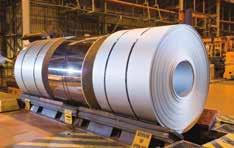
The company supports the livelihoods of 1 250 employees and 600 contractors and we create in the region of 150 job opportunities annually for young trainees. Through its BBBEE programme, Columbus Stainless actively promotes doing business with small, medium and micro enterprises (SMMEs) owned or controlled by black entrepreneurs that are able to supply quality products and services in a timely and competitive fashion.
We are proud to have contributed to the supply and development of stainless steel for close to six decades and will continue to support the growth in Africa’s manufacturing industry through sound technical advice and premium customer service.
Products
For most projects, current economic constraints require a balance between materials of construction selected and ultimate cost savings. The selection of stainless steel in this economy becomes the obvious choice. Stainless steel is a versatile metal of construction – its corrosion resistance and elegant appearance offers longevity and low maintenance in service. The added
Columbus Stainless produces the three main families of stainless steel, namely Austenitic, Ferritic and Duplex grades, which are suitable for most applications including agro-processing, food-processing equipment, mining and power generation – including nuclear, chemical, automotive and manufacturing industries.
Ferritic Stainless Steel: Commonly known as plain chromium steels. Typical examples include grades 430, used for applications like cutlery, cookware and architectural applications like wall cladding, hand rails and balustrades.
Utility Ferritic Stainless Steel: 3CR12® is a world-renowned low-cost utility ferritic stainless steel developed by Columbus Stainless and is used in structural applications. This material bridges the gap between coated carbon steels and the traditional higher alloyed stainless-steel grades. Due to excellent properties in wetabrasion conditions, 3CR12® is used successfully in the mining industry to fabricate ore-handling equipment, conveyor-belt systems and ore wagons. Applications in the agro-processing industries include handling and processing equipment, handrails, floor gratings and walkways. 3CR12® has seen great success and longevity in roofing and cladding applications, even in highly corrosive ammonia-containing environments like chicken farms, piggeries and other livestock holding facilities.
Austenitic Stainless Steel: These steels are alloyed with chromium and nickel for improved corrosion resistance, fabricability and exhibit good strength properties both in cryogenic temperatures (for example, cold storage containers) and high temperatures (ovens, stoves and cookware). Common grades include 304 and 316, which are used extensively in the food-
52 MPUMALANGA BUSINESS 2023/24
FOCUS
processing industry, demanding high hygienic properties. Typically used in agriculture and abattoirs (including dairy processing and meathandling equipment, food and beverage storage tanks); catering and hospitality (cooking utensils, food-processing equipment, cold storage and healthcare industries for medical equipment and surgical tools); mining and chemical industry (cathode plates, processing tanks).
Duplex Stainless Steel: These grades exhibit high strength, good resistance to stress corrosion cracking and superior corrosion resistance. Popular grades include lean duplex 2304 and standard duplex grade 2205. Successful applications are in the paper and pulp industries, chemical, petrochemical and mining industries for various processing equipment and storage tanks. Due to their superior corrosion resistance these steels can withstand harsh marine environments. Our duplex stainless steel grade 2205 has been used and qualified in South African nuclear applications.
Outlasting harsh conditions
Case study: 3CR12 railway electrification masts in Gqeberha
Corrosion is the natural, gradual deterioration of metals reacting with their environment, compromising the useful properties of metals and structures, including their strength and structural integrity. In the ambient environment, metal alloys tend to revert back to their natural stable states. Carbon steels, for example, are made up of iron and a combination of other alloying elements. Without any additional surface protection, they tend to form a layer of rust (iron-oxide) which is brittle and exfoliates, exposing a new fresh layer of steel to be attacked. This cycle continues with
devastating effects to equipment and structures due to resultant loss in through-thickness and inevitably causing perforation. Stainless steels have a unique advantage in that a thin, self-repairing protective layer forms on the surface of the steel. This chromium oxide passive layer gives the steel its characteristic corrosion-resisting properties in most environments. The steel must contain at least 10.5% chromium for this passive layer to form.
There are many modes of corrosion; atmospheric corrosion is one of the most widespread causes of metallic degradation. It occurs as a reaction of a metal to its immediate environment. It is generally predictable and measurable, and therefore can be designed into a structure by adding thickness factor. Examples of successful use of stainless steel in a corrosive environment are the railway electrification masts in Gqeberha. The line runs from the harbour along the coast to the North End, moving inland. During high tide and windy conditions, the masts are constantly exposed to sea spray. The metal of construction used is utility ferritic stainless steel grade 3CR12®. Installed in 1982, these masts have seen very aggressive coastal environmental conditions. But after 40-plus years in operation, the structure is still in pristine condition, with minimal thickness reduction experienced. This proves that the longevity of the product and minimal maintenance are critical attributes to consider when selecting materials of construction.
Stainless steels are known for their superior corrosion resistance and are mainly used in the bare mill finish without the need for additional protective coating systems to enhance corrosion protection – hence cementing them as the lowlife-cycle-cost metals of choice.■

FOCUS
Transport and logistics
Major bridge and road projects are underway.
The South African National Roads Agency (Sanral) will spend R9-billion on road infrastructure in Mpumalanga. The agency, which is responsible for national roads, is concentrating on the upgrading of the N2 between Ermelo in Mpumalanga and KwaZulu-Natal and the R40 between Hazyview and Bushbuckridge.
The performance of the Maputo Corridor has enabled one of South Africa’s biggest logistical carriers to continue to post good financial results. With the N3 highway between Johannesburg and Durban often congested and delays at the ports of Richards Bay and Durban, Super Group reports that the route through Mpumalanga to Mozambique is functioning well for its trucks.
In comparison with December 2019, group revenue increased by 54.4%, with non-South African operations contributing 51% to that figure. Super Group operates in 21 countries.
Trans Africa Concessions (TRAC), the toll road company, will spend R248-million on expanding capacity on the bridge over the Crocodile River and creating an upgraded roads junction at the Montrose interchange. Two new bridges will be built to provide access over the Elands Valley section of the road. The Motheo Group, in a joint venture with WBHO, has been working on the N4 for TRAC, which has also parcelled out some work to Raubex Construction.
The Karino Interchange project on the N4 which provides a link between Mbombela, Kanyamazane, the N4 and access to the Kruger Mpumalanga International Airport has also been completed and is operational.

In addition to the Karino interchange, Sanral is working on various other projects in the province, such as the Moloto Road that connects the provinces of Gauteng, Mpumalanga and Limpopo. On internal roads within the province, severe damage was caused by Tropical Storm Eloise. The Tekwane South Bridge on the D2296 collapsed but it is now back in full operation.
A road that has been identified as a provincial priority is the P216/1 from Secunda to eMbalenhle, which we will be constructed by the provincial government in the 2023/24 financial year. A bridge from Emalahleni city centre to Pine Ridge, Clarinet, Siyanqoba and Verena will improve safety and traffic flow.
Volume of traffic
It has not just been heavy rains that have put a strain on the
54 MPUMALANGA BUSINESS 2023/24
The Maputo Corridor is performing well for logistics companies
SECTOR INSIGHT OVERVIEW
The Karino Exchange. Credit: Sanral
roads. The heavy traffic that feeds coal mines and power stations is another source of stress. The Provincial Government of Mpumalanga has purchased mechanised pothole-patching vehicles in response to this problem. It is expected that many jobs will also be created in this attempt to improve the strategic road infrastructure network, which includes tourism routes.
Sanral has announced a three-year project which will provide work for small contractors in and around the City of Mbombela. More than R26-million has been allocated to subcontracting which will cover things like litter and minor works, minor maintenance, vegetation and bush clearing.
There is more freight rail traffic in Mpumalanga than in any other province. This is principally because of the transport of coal, but there are also large volumes of chrome, ferrochrome, forestry products, chemicals, liquid fuels and general freight.
The Balfour North to Volksrust section of the Gauteng to Durban mainline carries the largest volumes, most of which is long-haul freight passing through the province. Despite these high rail volumes, a huge amount of mineral product is transported by truck around and out of the province. This puts immense pressure on Mpumalanga’s roads network, particularly in the Gert Sibande District and the Nkangala District.
The statistics relating to coal haulage in Mpumalanga are stupendous. In one 12-hour period, 34 198 tons of general freight were recorded for the section of the N4 highway between Nelspruit and Komatipoort.
Mactransco’s website states that its trucks serving Tshikondeni Coal Mine travel 3.7-million kilometres per year, working all day for six days a week. The fleet of ABF Legend Logistics, a Super Group company, contains more than 200 super-link coal haulage trucks while another company in the group, SG Coal, claims to have one of the biggest fleets of coal haulage trucks in Africa. Coal Tipper Resources operates out of Bethal.
Air access
Eurowings Discover, a new division of Lufthansa, announced in 2022 that it would start flying three times a week to Mbombela from Frankfurt, via Windhoek, in November.
By landing at Kruger Mpumalanga International Airport (KMIA), German tourists will have quick access to the Kruger National Park.
ONLINE RESOURCES
Kruger Mpumalanga International Airport: www.kmiairport.co.za
Maputo Corridor Logistics Initiative: www.mcli.co.za
Railroad Association of South Africa: www.rra.co.za
South African National Roads Agency Ltd: www.sanral.co.za
Eurowings Discover was launched in July 2021 as a long-haul leisure airline, not to be confused with the low-cost airline, Eurowings. In May 2022 the airline had 16 aircraft.
Airlink, which has 36 destinations in nine African countries, is the other airline that regularly flies into KMIA. Fastjet connects KMIA to Victoria Falls, Zimbabwe. From there, Fastjet links that destination to the country’s two major cities, Harare and Bulawayo. KMIA serves an average of 260 000 per annum.
Hoedspruit Eastgate Airport is a popular destination for travellers on their way to private game lodges and is also near the Orpen Gate of Kruger Park. SA Express flies to Hoedspruit from Johannesburg and Cape Town.
Middelburg Airfield is one of the larger alternate airports in the province, boasting a 1.9km runway that can accommodate a 737. The annual Middelburg Air Show is held in June. Many game lodges have airstrips and helipads. SA Red Cross Air Mercy Service operates out of the old Nelspruit airport south of the city. ■

55
OVERVIEW
The African-themed terminal buildings at Kruger Mpumalanga International Airport always make an impression. Credit: KMIA
Tourism
A multi-pronged domestic promotion effort is underway.
SECTOR INSIGHT
The Southern Sun brand has risen again.
aircraft. Flying three times a week to Mbombela from Frankfurt via Windhoek, it gives much more direct access to the Kruger National Park than had previously been the case for international tourists, who always used to have to go through Johannesburg.
The Mpumalanga Tourism and Parks Agency (MTPA) ran an energetic winter campaign through the months of June and July 2023, aimed at encouraging domestic tourists to experience the province’s many attractions.
Partly based on the fact that Mpumalanga is relatively warmer than many other parts of the country at that time, the campaign was part of a broader campaign that has seen marketing efforts ramped up.
Social media and radio were employed. As Mduduzi Vilakazi, Acting CEO of the MTPA, said, “Our objective with this campaign is to grow the domestic trips and regional arrivals to the destination. We want to create awareness of Mpumalanga’s hidden gems, the less-visited tourism offerings as well as promote affordable family packages to some of our nature reserves.”
Another plank of the province’s marketing drive involved persuading national broadcaster SABC to host its Metro FM awards in Mpumalanga for three years, highlighting the arts and cultural offerings in the province.
The focus has not been exclusively domestic, however.
The new flight from Frankfurt, Germany, to Kruger Mpumalanga International Airport (KMIA) had delivered 182 tourists to the province at the time of the State of the Province address by the Provincial Premier in February 2023.
The flight had only been announced by Eurowings Discover, a new division of Lufthansa, in 2022 and the first flight landed in November of that year. Eurowings Discover was launched in July 2021 as a long-haul leisure airline. In May 2022 the airline had 16
Plans are underway to collaborate with the airline and with South African Tourism to conduct a city-to-city tour in Europe to make more tourists aware of Mpumalanga’s offering.
The Provincial Government of Mpumalanga is looking for more private partners to invest in projects to boost an already active sector that has several superb tourism assets, ranging from about 70 parks and reserves to bird-watching, music festivals, car rallies and casinos.
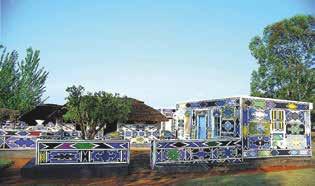
A total of R475-million in public and private investments has so far been raised for the Skywalk project at God’s Window in the Blyde River Canyon Nature Reserve. The community that owns the land will be a shareholder. The aim is to attract between 45 000 to 60 000 tourists to the Panorama tourism route. The project is expected to be completed in March 2025.
Another PPP project is the development of a cable car linking the Drierondavels viewing site with Swadini Dam.
56 MPUMALANGA BUSINESS 2023/24
OVERVIEW
Cultural and heritage tourism are markets with huge potential. Credit: MTPA
The Kruger National Park is Mpumalanga’s most famous tourism asset and it falls under South African National Parks (SANParks). Other notable landmarks include the Blyde River Canyon and the Makhonjwa Mountains, which have been declared a World Heritage Site by the United Nations Educational‚ Scientific and Cultural Organization (UNESCO). During her 2023 State of the Province Address, Premier Refilwe Mtshweni-Tsipane referenced a number of additions that will go into making the site more accessible to academics and casual tourists alike: an education centre, geo-sites and geo-trails are all planned. Although the province already caters for motor-rally enthusiasts, cyclists, runners, walkers, fishers, horse-riders, tree-gliders, abseilers, white-water rafters and rock-climbers, there is still potential for more investment in the ecotourism and adventure tourism subsectors.
Hotels
As of May 2022, Tsogo Sun Hotels again adopted the Southern Sun brand. With the fairly recent acquisition of the Hazyview Sun,
ONLINE RESOURCES
Mpumalanga Gaming Board: www.mgb.org.za
Mpumalanga Tourism and Parks Agency: www.mtpa.co.za
South African National Parks: www.sanparks.co.za

South African Tourism Services Association: www.satsa.com
the group has a total of seven properties in the province, ranging from two StayEasys to Southern Sun Emnotweni in Nelspruit.
Tsogo Sun, as distinct from Tsogo Sun Hotels which is no more, has interests in casinos and gaming and runs two hotels in Witbank (eMalahleni), The Ridge Hotel and the RidgePoint Hotel.
Protea Hotels by Marriott has two properties in Mpumalanga, Protea Hotel Kruger Gate and Nelspruit. At White River, Premier Hotel The Winkler is 20 minutes’ drive from the Numbi Gate of the Kruger National Park.
Forever Resorts has a big presence in the province, catering to caravanners, campers and holiday-makers wanting to stay in chalets. There is also a four-star Forever Resorts Mount Sheba.
The Graceland Hotel Casino and Country Club is a Peermont resort in Secunda.
The hotel and conference centre project in Middelburg is making progress and should be completed in 2023. The R350-million luxury facility in the Steve Tshwete Local Municipality is a public-private partnership. Akani Properties, a black-owned property development company, will work with the Radisson Hotel Group to deliver the 150-bed hotel and convention centre.
More than 100 new job opportunities have been created so far on the project, and more than 20 local contractors have been engaged. ■
57 MPUMALANGA BUSINESS 2023/24
It’s not only the Big Five that attract attention. Waterbuck at Sabi Sand Nature Reserve. Credit: Julie Olivier
OVERVIEW
ICT
A Mpumalanga coal mine is using 5G.

SECTOR INSIGHT
ICT is a critical research theme at the University of Mpumalanga.
Canyon Coal’s Phalanndwa Colliery, pictured, is South Africa’s first smart mine. Located near Delmas, the mine produced 1.7-million tons of run-of-mine coal in 2022.
Together with Minetec Smart Mining, Huawei and MTN are partnering to keep the mine and plant connected and monitored using high-speed broadband, through the site’s 5G connectivity. The same partners are working together in Limpopo on a platinum mine and it is expected that many more mines will follow these pilot projects in trying to make the country’s mining sector safer and more automated.
ICT has been chosen as one of the University of Mpumalanga’s six critical research themes. Operating under the title of Information and Communication Technology for Development (ICT4D), it intends to present easy adoption and use of ICT resources for the betterment of people’s day-to-day activities. Sub-themes are ICT in education, cybersecurity, Internet of Things and data analytics.
The university offers a Diploma in ICT in Applications Development, a three-year course carrying 360 credits and a level-
ONLINE RESOURCES
Seda Technology Programme: www.seda.org.za
State Information Technology Agency: www.sita.co.za
Universal Service and Access Agency of South Africa: www.usaasa.org.za
six qualification. Three years after starting to offer free WiFi in its operating areas, Glencore Coal and partner Project Isizwe celebrated estimated savings in data costs of more than R100million. Having started with 10 hotspots in Ogies and Phola in the eMalahleni Municipality, the initiative was expanded to the Steve Tshwete and Emakhazeni municipalities where 30 hotspots now function. Communities are consuming more than 28 000GB of data for free every month. Project Isizwe is a non-profit organisation that partners with Internet Service Providers to provide equitable Internet access.
The MTN SA Foundation supports several schools in Mpumalanga as part of MTN’s Back to School campaigns. Eleven schools have multi-media centres, each with 20 computer desks, chairs and teacher stations. The computer laboratories have one server, a multifunctional printer, an interactive whiteboard, a data projector, a router and data connectivity to MTN for 24 months. The province’s new boarding school, Izimbali Combined MST, also has a 40-seater laboratory courtesy of the MTN SA Foundation. ■
58 MPUMALANGA BUSINESS 2023/24 OVERVIEW

Still struggling to manage your network at branch level? #BusinessDoneBetter with MTN SD-WAN Solutions A software driven WAN solution from MTN Business will allow you to centralise and integrate the management of your multisite network with spectacular benefits. It will reduce cost and complexity, optimise cloud access, increase visibility and control, and vastly improve the end-user experience. Visit mtnbusiness.co.za Email getconnected@mtn.com TBWA\HUNT\LASCARIS 940009
Education and training
Digital skills are coming to Mpumalanga.
SECTOR INSIGHT
part of a scheme to strengthen Early Childhood Development. The Ephraim Mogale Bursary Scheme supported 1 370 students in different universities within the country and the Mpumalanga Department of Education supported 221 students at various level in the Federal Republic of Russia.
As part of a programme to spread skills to young people living in rural areas, an eco-friendly SMART Skills Centre is to be built in Sabie. The timber structure results from a partnership between the Chemical Industries Education and Training Authority (CHIETA) and the South African Forest Company Limited (SAFCOL).
CHIETA aims to provide digital technology and online learning to help young people compete in the job market. Among the forestry-related skills that the centre will focus on are drone operators, but it will also respond to national skills needs such as fitters and turners. SAFCOL will cover the cost of erecting the ecofriendly wooden structure and CHIETA will supply the equipment.
The development of the Komati Training Facility to facilitate the reskilling and retraining of Eskom employees and members of the community has begun. Eskom has signed a partnership agreement with the South African Renewable Energy Technology Centre (SARETEC) of the Cape Peninsula University of Technology and the Global Energy Alliance for People and Planet (GEAPP) to develop the training facility.
Four new primary schools have been completed in areas where the population has been growing, namely Magogeni, Mpumelelo, New Klarinet and Mbatini. A further five schools, including Mkhondo Boarding School, are set for completion in the course of 2023. Designs for Long-Tom Secondary and Rockdale Extension 24 are being finalised and construction will begin in 2023/24.
The Funza Lushaka Bursary Scheme will be used to encourage Grade 12 matriculants to consider pursuing Grade R teaching as
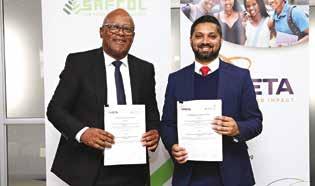
Tertiary progress
On a hill north of the Crocodile River a complex of buildings is taking shape as home to the province’s first university. By building on existing institutions such as teacher training colleges, the University of Mpumalanga has progressively offered more courses and taken on more students. The official launch was in October 2013 and by 2020, the university was offering 26 qualifications to 4 200 students. The university currently offers 48 programmes in three faculties: Education; Agriculture and Natural Sciences; and Economics and Business Sciences. There are plans to add new programmes at both undergraduate and postgraduate levels and to establish the faculty of Humanities and Social Sciences and the School of Law. By 2024, the plan is to offer approximately
60 MPUMALANGA BUSINESS 2023/24
Mpumalanga has three TVET colleges.
OVERVIEW
The CEOs of SAFCOL, Tsepo Monaheng, and CHIETA, Yershen Pillay, recently signed an MoU.
70 qualifications to over 8 000 students. That is the year in which the university’s first doctoral graduates will be capped. Research relevant to the needs of the province can now be done at local level. Issues such as acid mine water leaking from abandoned mining sites and new applications for products in the timber industry are among the kinds of research that will boost economic productivity in Mpumalanga, and lead to better socio-economic conditions for citizens.
University of Mpumalanga students have distinguished themselves in competitions run by ENACTUS, an international organisation that works with leaders in business and higher education to mobilise university students to make a difference in their communities while developing the skills to become socially responsible business leaders. Mpumalanga students have won first place in categories such as LED Challenge, Triple Bottom Sustainability and Community Development. Among the anchor sponsors are Barloworld, Ford, Harmony Gold, MTN and Nedbank.
Training institutions
Mpumalanga has three Technical and Vocational Education and Training (TVET) colleges, with an enrolment of over 36 000. UNISA, the Tshwane University of Technology and the Vaal University of Technology also have satellite campuses in the province.
The TVET colleges are located in each of the province’s three District Municipalities: Gert Sibande (four campuses and a skills academy), Nkangala and Ehlanzeni, which has six campuses, a skills centre and a satellite campus.
Ehlanzeni TVET College offers 10 National Certificate (Vocational) programmes including ICT, Finance, Economics and Accounting, Engineering and Related Design and Tourism. There are also a number of shorter skills courses on offer.
Nkangala TVET College offers Civil Engineering and Building Construction at its CN Mahlangu campus and Electrical Infrastructure Construction at three of its five campuses, among its seven NCV academic programmes. The Mpumalanga Regional
ONLINE RESOURCES
Mpumalanga Department of Education: www.mpumalanga.gov.za/education
Sasol bursaries: www.sasolbursaries.com
Southern African Wildlife College: www.wildlifecollege.org.za
University of Mpumalanga: www.ump.ac.za
Training Trust (MRTT) is a Section 21 company active in skills training. The Fluor Training Centre in Secunda offers training in fields such as fitting, welding, pipefitting and other building trades.
The Southern African Wildlife College, offering diploma and short courses in conservation, is a joint World Wide Fund for Nature South Africa (WWF-SA) and Peace Parks Foundation initiative. The college is located near the Orpen Gate on the edge of the Kruger National Park.

Sasol is a major supporter of research and training in the province. A group of Mpumalanga teachers has had the opportunity to train as master teachers for Robotics and Coding, courtesy of Sasol.
The Sasol Foundation has also donated multimedia resources for teachers and pupils in Science, Technology, Engineering and Mathematics (STEM). Awards for students who achieve in science and mathematics are regularly given and Sasol supports many students on bursaries at universities and colleges. The Sasol SGS Global Learning SHE Academy is located in Evander. ■
61 MPUMALANGA BUSINESS 2023/24
The University of Mpumalanga is building impressive facilities.
Banking and financial services
Banking while shopping is becoming commonplace.
Being able to do one’s banking at somewhere that is not a bank is not a new concept. However, TymeBank, one of the newer entrants onto the South African banking scene, is taking the concept of “retail banking” to another level. Having run banking kiosks within retailers such as Pick n Pay and Boxer for several years, TymeBank has signed a deal with TFG, a group that has a big presence in the Mpumalanga. There are no fewer than 24 Exact stores in Mpumalanga, from Acorn Plaza to Witbank.
What used to be known as the Foschini Group has 34 brands, including Markhams, Totalsports, Jet and Dial a Bed, and 30-million customers. In the short term, TymeBank will have access to 600 TFG kiosks, taking the bank’s total in South Africa to 1 450.
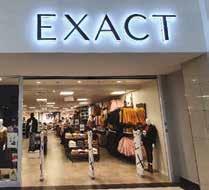
Another relatively new bank is Capitec. Investment holding company PSG has reduced its holding in Capitec Bank from 32% to 4%, earning about R4-billion by selling those shares.
Discovery Bank officially launched in March 2019 and is experiencing rapid growth with deposits of R3.7-billion. Discovery Bank is applying the behavioural model it uses in its health business to reward good financial behaviour.
In 2022, financial services group Old Mutual received permission from the prudential authority of the South African Reserve Bank to apply for a banking licence. The bank will spend R1.75-billion on setting up the bank and intends to launch in 2024.
Ubank, with a history of catering to mineworkers, was found by the South African Reserve Bank to have an unacceptable capital adequacy ratio in May 2022 and was consequently placed under curatorship. Teba Trust Fund, which owns Ubank, was actively seeking a strategic investor when the curatorship was announced. The administrators of the fund are the National Union of Mineworkers (NUM) and Minerals Council SA. One of the banks being courted was the South African arm of Nigeria’s Access Bank Group and Minerals Council SA remains positive about the future of the bank.
Despite the collapse of VBS Mutual Bank in 2018, the appetite for mutual banks is strong, given the nature of the South African market.
ONLINE RESOURCES
Financial Sector Conduct Authority: www.fsca.co.za
Public Investment Corporation: www.pic.gov.za
South African Reserve Bank: www.resbank.co.za
The Young Women in Business Network (YWBN) has been granted a mutual bank licence and Bank Zero also intends to use the mutual model.
South Africa’s four big retail banks (Nedbank, Absa, Standard Bank and First National Bank) have a solid presence in the major towns in the province.
Agriculture is an important focus area for banks, and most have specialised divisions.
Piet Retief-based TWK Agri offers financing and insurance together with the usual suite of agricultural services. Afgri, one of the country’s biggest agricultural companies, offers financial services (financing and insurance) under the brand Unigro. ■
62 MPUMALANGA BUSINESS 2023/24
Old Mutual has permission to start a bank.
SECTOR INSIGHT
OVERVIEW







O F FICIALMOBILEPROVID E R RSAGOVERNMENT Visit mtnbusiness.co.za Email RT15cutomercare@mtn.com
OVERVIEW
Development finance and SMME support
The transition to a green economy may bring opportunities.
With the transition to a greener economy a key trend, the Provincial Government of Mpumalanga wants to leverage the coming change in the economic landscape to benefit small businesses.
In partnership with the Presidential Climate Commission, the Climate Investment Fund and the World Bank, opportunities are being explored for SMMEs and co-operatives to participate in the green economy.
The Premier’s Youth Development Fund allocated R92.3-million to 36 companies in the financial year to February 2023 in sectors such as agriculture, manufacturing, mining and transport and logistics. Since it was launched, the fund has disbursed R140-million to businesses in each one of the province’s 17 local municipalities. In order to further spread the reach of the fund, roadshows are to be held in rural areas.
The provincial government is committed to allocating 30% of the provincial procurement budget to enterprises owned by women, youth and people with disabilities.
Research done by the Small Enterprise Development Agency (Seda) shows that a high percentage of SMMEs in Mpumalanga are in the trade and accommodation sector. Whereas the national figure is about 43%, in Mpumalanga it is closer to 50%. Seda supports several incubators in the province: Furntech, furniture manufacturing, White River; Mobile AgroSkills Development & Training (MASDT), agricultural training, Nelspruit; Mpumalanga Stainless Initiative (MSI), stainless-steel processing, Middelburg (with Columbus Stainless); Timbali floriculture, Nelspruit; Ehlanzeni TVET College Rapid Incubator Renewable Technologies, Nelspruit. TVET stands for technical and vocational education training.

The Gert Sibande Centre for Entrepreneurship in Evander hosts a Rapid Incubator in partnership with Seda. The aim is to promote and develop young entrepreneurs in the province. The Centre was established in 2015 through a partnership between the Gert Sibande TVET College, the DSBD and the University of Johannesburg.
Entrepreneurship Development is one of the subjects on offer at 90 Youth Development Centres which are being established. Sappi’s extensive supply chain allows for a varied and extensive enterprise supplier development
ONLINE RESOURCES
Gert Sibande TVET College: www.gscollege.edu.za
Mpumalanga Economic Growth Agency: www.mega.gov.za
Mpumalanga Stainless Initiative: www.mpstainless.co.za
Small Enterprise Development Agency: www.seda.org.za
programme which supports 37 companies, which in turn employ more than 300 people.
Other companies supporting SMMEs through their buying chain include Woolworths and Anglo American. Woolworths funds TechnoServe to ensure that small tomato growers can grow produce that will meet the demanding standards of the retailer, and to help them expand production.
Premier Refilwe MtshweniTsipane has paid tribute to private companies for providing employment opportunities to local people and for continuing to support small and emerging businesses. Bursary programmes and training programmes were also acknowledged. The companies mentioned were Sasol, Exxaro, Eskom, Sappi, Columbus Stainless, Samancor, RCL foods, Mondi, Safcol, Glencore, Standard Bank, Absa Bank, Nedbank and First National Bank. ■
MPUMALANGA BUSINESS 2023/24 64
TechnoServe helps tomato growers meet higher standards.
SECTOR INSIGHT



Out of the office, but never out of the loop. #BusinessDoneBetter with MTN Business Unified Communications Enhance collaboration and customer service with cost-effective technologies from MTN Business. Stay connected with our range of services, including Fixed voice, SIP trunk, Hosted PBX, Mobile PBX, Hosted Contact Centres and more. TBWA\HUNT\LASCARIS 940004 Visit mtnbusiness.co.za Email getconnected@mtn.com
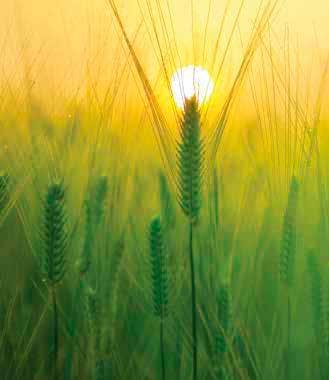
MBOMBELA HEAD OFFICE: T +27 13 492 5818 www.mega.gov.za • trade-invest@mega.gov.za
























 Isaac Mahlangu, CEO, MEGA
Isaac Mahlangu, CEO, MEGA

































 By John Young
By John Young























































































